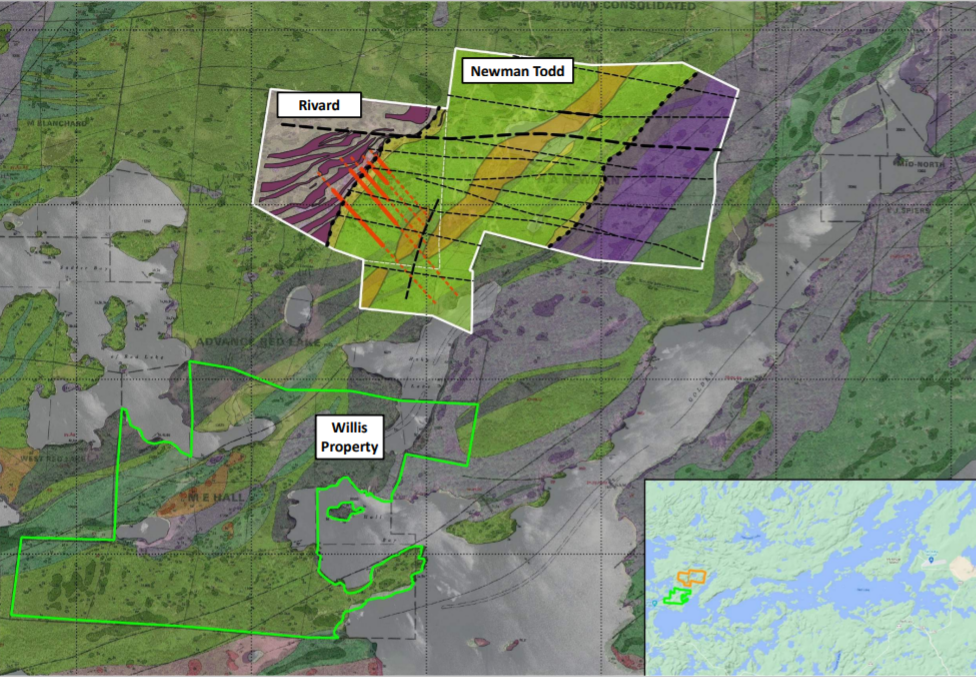
Trillium Gold Mines Inc. (TSXV:TGM), a gold mining company focused on acquisition, exploration, and development at the Red Lake Mining District of Northern Ontario, has been busy in 2021.
Trillium has assembled the largest prospective land package in and around the Red Lake mining district in Northern Ontario. Red Lake has many major mines and deposits, and the greenstone belts of Confederation Lake and Birch-Uchi. The company is advancing drill programs at multiple properties including Willis, Newman Todd, a significant portion of the Confederation Lake Greenstone Belt, and properties in Larder Lake, Ontario, and Matagami and Chibougamou areas of Quebec.
New Results Continue to Pour In
The company announced on September 8 that the majority of assays from drilling at the Newman Todd Complex had been received, with assay reporting over two months. The company was able to process and summarize samples representing 6,708 metres across 15 drill holes at the property.
The Rivard and Newman Todd properties were explored in isolation and not systematically drilled for an integrated structural understanding.
Highlights
| Newman Todd | ||
| NT21-185: | 17.6m @ 1.35 g/t Au | |
| 13.2m @ 1.24 g/t Au incl. 0.5m @ 20.5 g/t Au | ||
| NT21-187: | 6.97m @ 7.5 g/t Au incl. 1m @ 45.9 g/t Au | |
| 4.75m @ 4.95 g/t Au incl. 0.65m @ 33.88 g/t Au and 0.35m @ 54.7 g/t Au | ||
| 6.2m @ 5.4 g/t Au incl. 0.3m @ 61.9 g/t Au | ||
| NT21-188: | 52.3m @ 1.07 g/t Au incl. 0.7m @ 11.5 g/t Au | |
| NT21-190: | 3.3m @ 8.06 g/t Au incl. 0.4m @ 61.9 g/t Au | |
| NT21-192: | 21.3m @ 3.55 g/t Au incl. 4.3m @ 13.8 g/t Au (includes 1m @ 35.15 g/t Au) | |
| Rivard | ||
| RV21-31: 0.3m @ 28.0 g/t Au | ||
| RV21-32: 0.3m @ 15.9 g/t Au | ||
| RV21-33: 0.7m @ 54.49 g/t Au incl. 0.4m @ 95.3 g/t Au | ||
| RV21-34: 2.2m @ 25.23 g/t Au incl. 0.3m @ 116 g/t Au and 0.3m @ 67.7 g/t Au | ||
Source: Trillium Gold Mines
Expanding the Property Portfolio
Trillium Gold (TSXV:TGM) also announced on October 26 that it had closed the acquisition of the of the Willis Property. Willis consists of thirteen patented mineral claim totalling 229 hectares. The company now holds a 100% interest in the Willis property, which is subject to a 2% net smelter returns royalty, half of which Trillium Gold has retained the right to repurchase for $1.2 million. If the holders of the royalty decide to sell the royalty in the future, Trillium also holds the right of first refusal.
MiningFeeds will begin covering news and insights from Trillium Gold (TSXV:TGM) as it continues to advance its drill programs in some of the best gold mining districts in the world, in one of the best mining jurisdictions in the world, Canada.
The above references an opinion and is for information purposes only. It is not intended to be investment advice. Seek a licensed professional for investment advice. The author is not an insider or shareholder of any of the companies mentioned above.
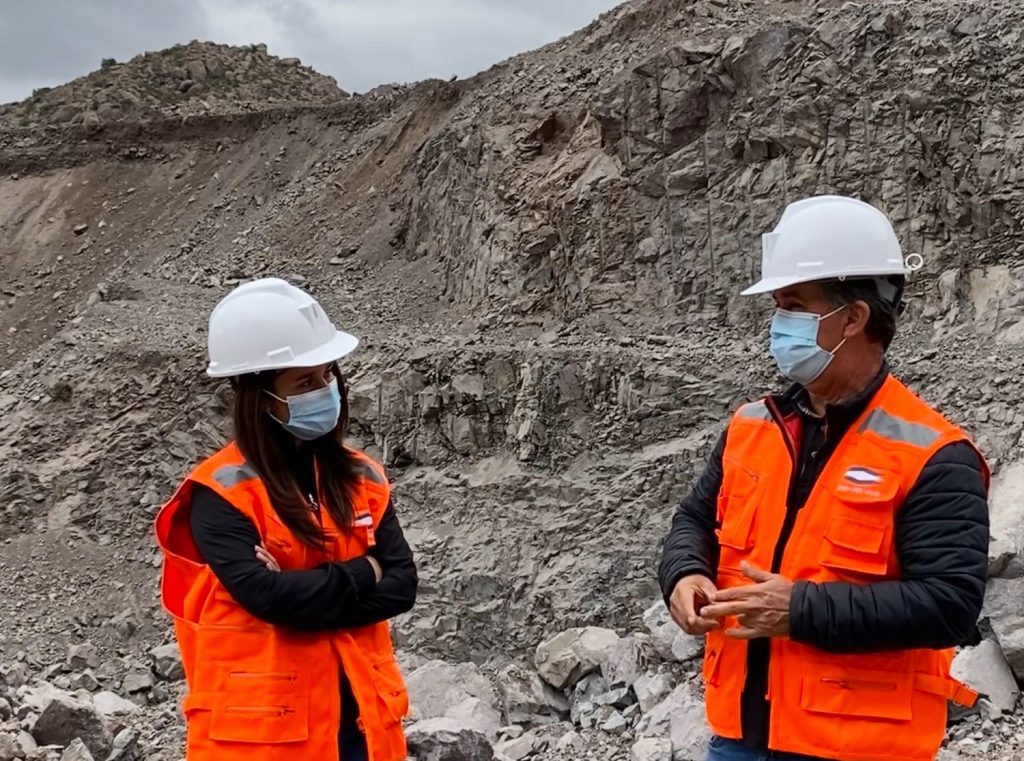
Three Valley Copper (TSXV:TVC) has announced its financial results for the three months and nine and months periods ended on September 30, 2021. As the company has closed its bought deal financing and looks to explore its huge property in Chile, the company is moving quickly in multiple areas of the business.
The multi-pronged approach to the project includes increasing copper production and furthering exploration of the property. The Minera Tres Valles property is 91.1% owned by Three Valley Copper, and is located in Salamanca, Chile. The property consists of 46,000 hectares of exploratory lands, of which 95% are still unexplored. The company’s position as a producer of 99.99% copper cathodes and an explorer of this large property puts it in a unique position in a copper market that is contnually clamoring for more.
Michael Staresinic, President and Chief Executive Officer of Three Valley Copper (TSXV:TVC), commented in a press release: “This past quarter showed a marked improvement with our flagship project, the construction and development of our underground mine, Papomono. Since the renegotiation of this contract in August, the contractor has performed much better than we previously experienced with multi 200-meter month advancements. We are approaching 90% completion of the required meters to begin producing and expect our first caving of ore to begin in January 2022.”
“As we continued our assessment of Papomono during the quarter given its paramount importance to the Company, it was concluded that to further ensure its successful ramp-up during 2022 and maximize its economic benefit, we decided to bring forward sustaining capital expenditures originally planned for later years to 2022. This decision came at a time when our open pit operations at Don Gabriel continued its underperformance delivering less ore at a lower grade that will lead to cathode production at the lower end of our 2021 revised guidance. The Company’s original plan for 2021 included reinvesting the cash flows delivered by Don Gabriel to fund development of Papomono but unfortunately, this has not happened and we foresaw near-term capital stresses to the business. Our announced strategic review in October was, in part, to help address this and quickly led to a required near-term financing raising gross proceeds of C$18.2 million.”
“With this financing we eliminated the short-term liquidity issue that was on the horizon allowing us to continue completing Papomono in January 2022 and increasing production in 2022. The completion of Papomono continues to be our focus and any deviation or delay would be value destructive to stakeholders. Our senior lenders agreed with us and as a condition of the financing, continued their strong partnership by agreeing to forbear on the debt repayments due in the first three quarters of 2022 while we together continue to renegotiate new repayment terms of the senior debt facility.”
“This new capital also allows the strategic review process to move forward without undue pressure. This new capital secures a better future for the MTV project and assists the strategic review process underway which ultimately we believe will increase shareholder value.
“Our exploration program continues and with over 46,000 hectares available to explore with highly prospective exploration targets including the 100 outcrop copper occurrences identified and 170,000 meters of diamond drilling performed by previous owners, we expect to provide preliminary results from this campaign in the first half of 2022. We hope this is the beginning of a multi-year exploration program and expansion of the copper resources contained in our land tenure.
“We are very proud of our health and safety record with every health and safety statistic reporting below the country averages and specific to COVID-19, our initiated on-site vaccination program has resulted in approximately 94% of the workforce receiving both doses of the vaccine and nearly 100% of the workforce has opted to participate. We have already begun a booster shot program to supplement this.
“Much has been accomplished by the team in Chile during 2021 through a restart of mining operations all complicated by the complexities of COVID-19. The copper price has remained above $4 per pound for almost all of 2021 and we see this level of support continuing. And the longer this trend continues, the more capital and attention the industry will attract. Three Valley Copper will not be overlooked. TVC is uniquely positioned among junior copper companies to take advantage of this coming cycle – fully built infrastructure, producing operations with defined deposits and, a rich land package in a very good neighborhood.”
Highlights from the press release are as follows:
Corporate
- The Company, through its indirectly held subsidiary (SRH Chile SpA), subscribed for additional common shares of MTV for approximately $1.0 million, resulting in the Company’s indirect holding of MTV increasing from 90.3% to 91.1% effective August 16, 2021.
- On October 4, 2021, the Company delivered to the minority shareholder of MTV (the “Minority Shareholder“) the required written notice of its intention to acquire the remaining interest in MTV held by the Minority Shareholder as per the call option notice requirements of the MTV shareholders’ agreement.
- On October 20, 2021, the Company engaged an independent financial advisor to review and evaluate potential alternatives that may further maximize value for the shareholders of the Company. These alternatives may include, inter alia, potential mergers, strategic partnerships, acquisition or dispositions of assets and/or refinancing or amending terms of the Company’s long-term debt.
- On November 25, 2021, the Company successfully closed a bought-deal offering (the “Bought-Deal Financing“) and issued a total of 56,681,000 units (the “Units”) and 819,000 additional common share purchase warrants (each, an “Additional
Warrant”) at an offering price of CAD$0.32 per Unit, for gross proceeds of CAD$18.2 million. Each Unit consists of one common share in the capital of the Company and one common share purchase warrant (each a “Warrant”). Each Additional Warrant and each Warrant is exercisable into one common share of the Company at an exercise price of CAD$0.45 for a period of 30 months from the closing of the Bought-Deal Financing. - Prior to closing the Bought-Deal Financing, the Company and its subsidiaries executed an undertaking agreement (the “Undertaking”) with the MTV senior secured lenders (the “Lenders“) to amend the loan repayment terms of the secured prepayment facility entered into with the Lenders and amended as part of MTV’s Judicial Reorganization Agreement (the “Amended Facility“). The Company and the Lenders have undertaken to execute a binding agreement to amend the loan repayment terms of the Amended Facility on or prior to September 30, 2022. Under the terms of the Undertaking the Lenders have agreed not to accelerate or enforce their rights or remedies under the Amended Facility should MTV fail to (i) make scheduled loan repayments on March 31, 2022, June 30, 2022 and September 30, 2022 and/or (ii) replenish the operating reserve account to reestablish the minimum reserve as required under the Amended Facility (each, a “Specific Event of Default“). As per the terms of the Undertaking, the forbearance period is from November 22, 2021 to October 1, 2022. The Undertaking also provides that the net proceeds of the Bought-Deal Financing that closed on November 25, 2021 will not be used to repay any of the loans outstanding under the Amended Facility during the forbearance period. The Lenders will cease to be bound by the Undertaking (i) should the Company not invest the net proceeds received on CAD$16 million of the Bought-Deal Financing into MTV between the closing of the financing on November 25, 2021 and April 30, 2022, (ii) if an event of default occurs under the Amended Facility other than a Specified Event of Default, or (iii) if the Company and the Lenders fail to enter into a definitive agreement by September 30, 2022, pursuant to which the loan repayment schedule in the Amended Facility is revised.
Operations
- The Company continued to further advance the development of Papomono during the third quarter of 2021. MTV completed the critical ventilation shaft and the ore pass, which will further accelerate the speed of its continued advance. As at October 31, 2021, the development of Papomono is approximately 77% complete and 87% of the required meters to begin producing have been completed.
- In August 2021, MTV negotiated an extension of its underground development contractor’s contract to include the remaining development work following the initial construction and development phase of the block caving project. This has enabled the contractor to have more success with their recruiting efforts of skilled workers, and as a result, performance improved significantly in August, September, and October with over 200 meters of advancement each month, a rate not seen since the construction began. The block caving construction project is on track for completion in early 2022 with the planned ramp-up of production during 2022.
- Effective August 1, 2021 MTV entered into an amendment to the offtake agreement (the “Offtake“) specific to the fixed price sales component with Anglo American Marketing Limited (“AAML“). Under the terms of the amendment, the remaining monthly deliveries of copper cathodes due under the fixed price portion of the Offtake are deferred until May 1, 2022 and all sales of copper cathodes commencing August 1, 2021 until April 30, 2022 will be sold at the prevailing spot price for copper cathode, less a nominal amount.
- Copper cathode production was 1,138 tonnes at an average grade of 0.52%, increasing production 10% from 1,035 tonnes at an average grade of 0.53% for the three months ended June 30, 2021, mainly due to a higher average grade of ore purchased from third-party small miners and Empresa Nacional de Minera (“ENAMI“) compared to the second quarter of 2021.
- For the nine months ended September 30, 2021, capital expenditures of $9.3 million were incurred related to the construction and development of the incline block caving mine at the Papomono Masivo deposit.
Financial
- Reported gross loss of $0.9 million on a realized average copper price2 of $3.58 compared to $2.82 in Q3 2020.
- Adjusted EBITDA from continuing operations1 of negative $0.4 million compared to negative $0.9 million in Q3 2020.
- Net loss per share attributable to owners of the Company of $0.02 compared to $0.01 in Q3 2020.
- During September 2021, the Company drew down the remaining $6 million loan facility available to it under the terms of the Amended Facility. This additional senior secured debt has substantially the same security and terms as defined in the Amended Facility but with a fixed annual interest rate of 11%.
Operational Results Summary
| Three months ended | Nine months ended | |||||||||||
| Operating information | Sept. 30, 2021 | Sept. 30, 2020 | Sept. 30, 2021 | Sept. 30, 2020 | ||||||||
| Copper (MTV Operations) | ||||||||||||
| Total ore mined (thousands of tonnes) | 178 | 49 | 550 | 351 | ||||||||
| Grade of ore mined (% Cu) | 0.52 | % | 0.88 | % | 0.54 | % | 0.86 | % | ||||
| Total waste mined (thousands of tonnes) | 739 | 118 | 1,358 | 853 | ||||||||
| Ore Processed (thousands of tonnes) | 231 | 90 | 680 | 474 | ||||||||
| Cu Production (tonnes) | 1,138 | 1,077 | 3,073 | 3,789 | ||||||||
| Cu Production (thousands of pounds) | 2,509 | 2,374 | 6,775 | 8,353 | ||||||||
| Change in inventory ($000s) | $ | 3,563 | (11 | ) | $ | 10,427 | (4,421 | ) | ||||
| Cash cost of copper produced 1 (USD per pound) | $ | 3.40 | $ | 2.44 | $ | 3.49 | $ | 2.75 | ||||
| Realized copper price 2 (USD per pound) | $ | 3.58 | $ | 2.82 | $ | 3.48 | $ | 2.46 | ||||
1 Cash cost per pound of copper produced includes all costs absorbed into inventory including inventory write-downs less non-cash items such as depreciation and non-site charges. It is a non-IFRS performance measure. Refer to Non-IFRS Performance Measures.
2 Realized copper price is a non-IFRS performance measures. Refer to Non-IFRS Performance Measures.
Ore Production
- Ore mined of 165,222 tonnes at a grade of 0.47% from Don Gabriel representing 93% of ore mined.
- 73% of ore processed from Don Gabriel; 22% from third-party small miners and ENAMI; 5% from Papomono Masivo.
- Produced 2.5 million pounds of 99.99% pure copper cathodes at a cash cost per pound produced1 of $3.40.
- Sold 2.3 million pounds of copper cathodes at an average realized copper price2 of $3.58 per pound.
- High unit costs expected throughout 2021 and into 2022 as the Company expects to operate below capacity until Papomono Masivo is in full production.
Construction and Development of Papomono Masivo
- Mineral reserve estimate for Papomono Masivo is 3,067kt of proven and probable mineral reserves (at a copper grade of 1.51%).
- Block caving construction 77% complete and 87% of the required meters to begin producing have been completed as at October 31, 2021 with 19 opened construction fronts.
- High grade ore being extracted as part of construction process.
- In August 2021, MTV negotiated an extension of the underground contractor, Aura, contract to include the remaining development work following the initial construction and development phase of the block caving project. This has enabled Aura to have more success with their recruiting efforts of skilled workers.
- Aura delivered significantly improved performance since August 2021 with over 200 meters of advance per month from August to October. October 2021 was the best month since commencement of the project with 220 meters of advance. The block caving construction project is on track for completion in early 2022.
Exploration
- In September 2021, the Company commenced its 2021 near mine exploration drilling program on MTV focused on testing high-potential copper targets located between Don Gabriel and Papomono, which sit approximately 3 kilometers apart.
- On September 28, 2021, the Company announced that it has identified a new porphyry target in its license area. The identified central core has dimensions of approximately 2km by 1km. This target is an example of the broader potential of this property as copper porphyry deposits are associated with some of the largest long life copper mines in the world, with Chile hosting the greatest concentration of these deposits.
- Dr. John Mortimer, senior exploration geologist, is leading the Company’s explorations activities and executing the exploration program at MTV.
- Significant strategic land package of over 46,000 hectares.
- Property in the well-known copper producing Coquimbo region which has Antofogasta Minerals’ Los Pelambres mine located approximately 50 kilometers to the east of MTV.
- With more than 100 copper outcrop occurrences and 70 artisanal mining sites with geological characteristics similar to that of the Papomono and Don Gabriel orebodies, together with near-term infill drilling opportunities, the Company believes there is significant exploration potential.
COVID-19
- Beginning in March 2021 and in conjunction with the Chilean Ministry of Mining, the Ministry of Health and the Regional Mining Secretary of Coquimbo, MTV initiated an on-site vaccination program by offering vaccinations to all MTV employees and contractors. To date, 2021, approximately 94% of the workforce have received both doses of the vaccine and nearly 100% of the workforce has opted to participate.
- MTV continued its vaccination campaign in October 2021, offering booster shots on site to all workers.
- In the third quarter of 2021, COVID-19 restrictions eased in Chile as cases trended downward, resulting in little impact on the Company’s operations during this period. Should these restrictions reappear in the future, the effect of the COVID-19 pandemic on the Company’s business activities will create elevated uncertainty and may further impact production and previous guidance.
- The Company continues its preventative, mitigating and containment measures to actively minimize the spread of COVID-19.
Financial Results Summary
| Three months ended | Nine months ended | |||||||||||
| Financial information (in thousands) | Sept. 30, 2021 | Sept. 30, 2020 | Sept. 30, 2021 | Sept. 30, 2020 | ||||||||
| Revenue | $ | 8,362 | $ | 5,610 | $ | 22,873 | $ | 17,700 | ||||
| Gross loss | $ | 881 | $ | 552 | $ | 3,070 | $ | 9,546 | ||||
| Net loss from continuing operations | $ | 1,474 | $ | 335 | $ | 9,407 | $ | 21,167 | ||||
| Net loss from discontinued operations | $ | — | $ | — | $ | — | $ | 2,241 | ||||
| Net loss for the period | $ | 1,474 | $ | 335 | $ | 9,407 | $ | 23,408 | ||||
| Net loss per share attributable to owners of the Company | $ | 0.02 | $ | 0.01 | $ | 0.16 | $ | 0.48 | ||||
| EBITDA from continuing operations 1 | $ | 2,254 | $ | 1,873 | $ | 1,347 | $ | (12,695 | ) | |||
| Adjusted EBITDA from continuing operations 1 | $ | (392 | ) | $ | (926 | ) | $ | 440 | $ | (4,529 | ) | |
| Gain (loss) on portfolio investments | $ | — | $ | 1,038 | $ | 107 | $ | (1,294 | ) | |||
| Impairment of non-current assets | $ | — | $ | — | $ | — | $ | (7,628 | ) | |||
| Reversal (write-down) of inventory | $ | — | $ | 665 | $ | (2,474 | ) | $ | (3,441 | ) | ||
| Gain on modification of debt | $ | — | $ | 3,487 | $ | — | $ | 3,487 | ||||
| Cash used in operating activities before working capital changes | $ | (1,229 | ) | $ | (1,097 | ) | $ | (103 | ) | $ | (4,412 | ) |
1 Refer to Non-IFRS Performance Measures
Financial Results
Revenues of $8.4 million for the three months ended September 30, 2021 were generated predominantly from the sale of copper cathodes. Finished goods inventory at September 30, 2021 was approximately $2.9 million. Copper cathodes sold for the three months ended September 30, 2021 of 1,060 tonnes was higher than the comparative quarter in 2020 of 858 tonnes with their respective revenues based on an average realized copper price of $3.58 per pound and $2.82 per pound.
The Company reported a gross loss of $0.9 million for the three months ended September 30, 2021, mainly due to higher operating costs resulting from lower-than-expected grades of the ore mined from Don Gabriel. A reversal of previous write-down of inventory of $0.7 million that was recorded as a decrease to cost of sales offset the gross loss of $0.6 million for the comparable quarter.
Revenues of $22.9 million for the nine months ended September 30, 2021 were generated predominantly from the sale of copper cathodes. Copper cathodes sold for the nine months ended September 30, 2021 of 2,975 tonnes was lower than the comparative period in 2020 of 3,068 tonnes. The decrease in tonnes of the copper cathodes sold in 2021 was more than offset by the average realized copper price of $3.48 per pound, which increased by 41% from $2.46 per pound in the nine months ended September 30, 2020.
The Company reported a gross loss of $3.1 million for the nine months ended September 30, 2021 that includes a write-down of inventory, net of reversals of $2.5 million that is recorded as an increase to cost of sales. Included in the gross loss of $9.5 million for the comparable period, is a write-down of inventory, net of reversals of $3.4 million that is recorded as an increase to cost of sales.
In accordance with the Offtake with AAML, MTV sold 46% of its copper cathode production at $2.89 per pound for the three months ended September 30, 2021. This percentage is higher than the expected 40% as copper cathode production was lower during the nine months ended September 30, 2021 than was anticipated when the fixed priced portion of the contract was entered into.
Effective August 1, 2021 MTV entered into an amendment to the Offtake specific to the fixed prices sales component with AAML. Under the terms of the amendment, the remaining monthly deliveries of copper cathodes due under the fixed price portion of the Offtake are deferred until May 1, 2022 and all sales of copper cathodes commencing August 1, 2021 until April 30, 2022 will be sold at the prevailing spot price for copper cathode, less a nominal amount. The remaining 12 months of contracted delivery amounts of the fixed price portion of the contract will resume on May 1, 2022 at the previous agreed fixed price of $2.89 per pound.
The increasing copper price together with MTV’s obligation to sell a set amount of its production at $2.89 per pound affected the economics of purchasing ore from third-party small miners at market until July 31, 2021, but thereafter, the amendment to the Offtake significantly benefited ore supply from third-party small miners. The amendment allowed the Company to purchase ore from third-party miners at more competitive rates driving a progressive increase in ore supply up to October 2021, when MTV purchased over 21,000 tonnes of ore from third-party miners, which was 17% above the expected 18,000 tonnes.
The Company’s general and administrative expense for the three and nine months ended September 30, 2021 was $1.3 million and $3.2 million compared to $0.8 million and $3.2 million, respectively, in the comparative periods, showing an increase in marketing expenses in the three months ended September 30, 2021, compared to the same period of 2020.
Finance expenses for the three and nine months ended September 30, 2021 totaled $2.4 million and $6.8 million compared to $1.2 million and $4.5 million, respectively, in the comparative periods, as the average balance of the Company’s long-term debt grew. Given the current grace period achieved for the long-term debt under MTV’s restructuring in 2020, cash interest payments made during the three and nine months ended September 30, 2021 amounted to $1.1 million and $1.8 million, respectively.
The Company reported a quarterly net loss attributable to owners of the Company of $1.3 million or $0.02 per share. Adjusted EBITDA (see Non-IFRS Financial Measures ) from continuing operations for the three months ended September 30, 2021 was negative $0.4 million or $0.01 per share. For the comparable quarter in 2020, the Company reported a net loss attributable to owners of the Company of $0.3 million or $0.01 per share and Adjusted EBITDA from continuing operations of negative $0.9 million or $0.03 per share.
In the first three quarters of 2021, the Company reported a net loss attributable to owners of the Company of $7.6 million or $0.16 per share. Adjusted EBITDA (see Non-IFRS Financial Measures ) from continuing operations for the nine months ended September 30, 2021 was $0.4 million or $0.01 per share. For the comparable quarters of 2020, the Company reported a net loss attributable to owners of the Company of $16.2 million or $0.48 per share and Adjusted EBITDA from continuing operations of negative $4.5 million or $0.14 per share.
In the first three quarters of 2021, cash used in operating activities was $9.8 million (cash used of $0.1 million before changes in non-cash components of working capital), compared with 2020 when cash used in operating activities was $2.4 million (cash used of $4.4 million before changes in non-cash components of working capital).
Cash Position, Working Capital and Net Debt
Cash and cash equivalents decreased to $6.7 million at September 30, 2021 from $12.0 million at December 31, 2020 mainly due to $9.8 million used in operating activities, $7.7 million of disbursed capital expenditures mainly related to the construction and development of Papomono Masivo and $1.8 million of interest payments; all partially offset by $8.3 million of net proceeds from the April 2021 bought deal financing, $6.2 million of net proceeds from loans and borrowings and $0.4 million of net proceeds from the exercise of warrants.
The Company has working capital (see Non-IFRS Financial Measures ) of $3.1 million at September 30, 2021 and approximately $27.5 million as at the date hereof. Cash position as at the date hereof is approximately $17.8 million.
The Company is substantially leveraged. The Company’s net debt (see Non-IFRS Financial Measures ) at September 30, 2021 was $67.1 million. The Company’s debt position continues to increase as it capitalizes interest and remains in a grace period for the majority of its debt (see the Undertaking in Recent Highlights previously).
Health and Safety
For the three months ended September 30, 2021, there was no Lost-Time Incident. MTV’s annual injury frequency index continues to remain below the average of the mining industry in Chile. The Company and MTV devote considerable time and effort to ensure that workers and contractors return safely to their families after each shift. Safety statistics are monitored and compared to the country and peer averages, and MTV pro-actively engages in education and assessment to achieve a goal of zero lost-time incidents.
Community and Environment
MTV continues to actively work with local communities and stakeholders and for the three months ended September 30, 2021, the MTV Foundation continued the funding of projects agreed to by the MTV Foundation board, which is largely composed of community representatives to help MTV understand the true needs of its neighbors, such as starting an eco-friendly cooperative at a local school. MTV’s ore purchase program also ensures support from local miners, buying ore from over 26 providers and supporting the development of over 300 small-scale miners through local mining unions.
Ongoing Arbitration
As previously disclosed, the Company is involved in an arbitration proceeding with the Minority Shareholder of MTV. The arbitration proceeding is continuing and no further material developments have occurred. The Company remains confident in its position and is monitoring the arbitration proceeding and its process closely.
Qualified Persons
The scientific and technical content contained in this news release is taken from the technical report (the “ Technical Report “) entitled “Minera Tres Valles Copper Project, Salamanca, Coquimbo Region, Chile NI 43-101 Technical Report” prepared by Dr Antonio Luraschi, RM CMC, Manager of Metallurgic Development and Senior Financial Analyst, Wood, Mr Alfonso Ovalle, RM CMC, Mining Engineer, Wood, Mr Michael G. Hester, FAusIMM, Vice President and Principal Mining Engineer, Independent Mining Consultants, Inc., Mr Enrique Quiroga, RM CMC, Mining Engineer, Q&Q Ltda, Mr Gabriel Vera, RM CMC, Metallurgical Process Consultant, GVMetallurgy, and Mr Sergio Alvarado, RM CMC, Consultant Geologist, General Manager and Partner, Geoinvestment Sergio Alvarado Casas E.I.R.L. all of whom were independent qualified persons as defined by NI 43-101 at the time the Technical Report was prepared. The Technical Report was filed by TVC on SEDAR (www.sedar.com) on December 14, 2018 and subsequently amended and restated on May 27, 2021. Readers are encouraged to read the Technical Report in its entirety except for certain sections withdrawn by the Company in relation to disclosure regarding the Preliminary Economic Assessment appearing in the Technical Report (see press release dated April 12, 2021).
The above references an opinion and is for information purposes only. It is not intended to be investment advice. Seek a licensed professional for investment advice. The author is not an insider or shareholder of any of the companies mentioned above.
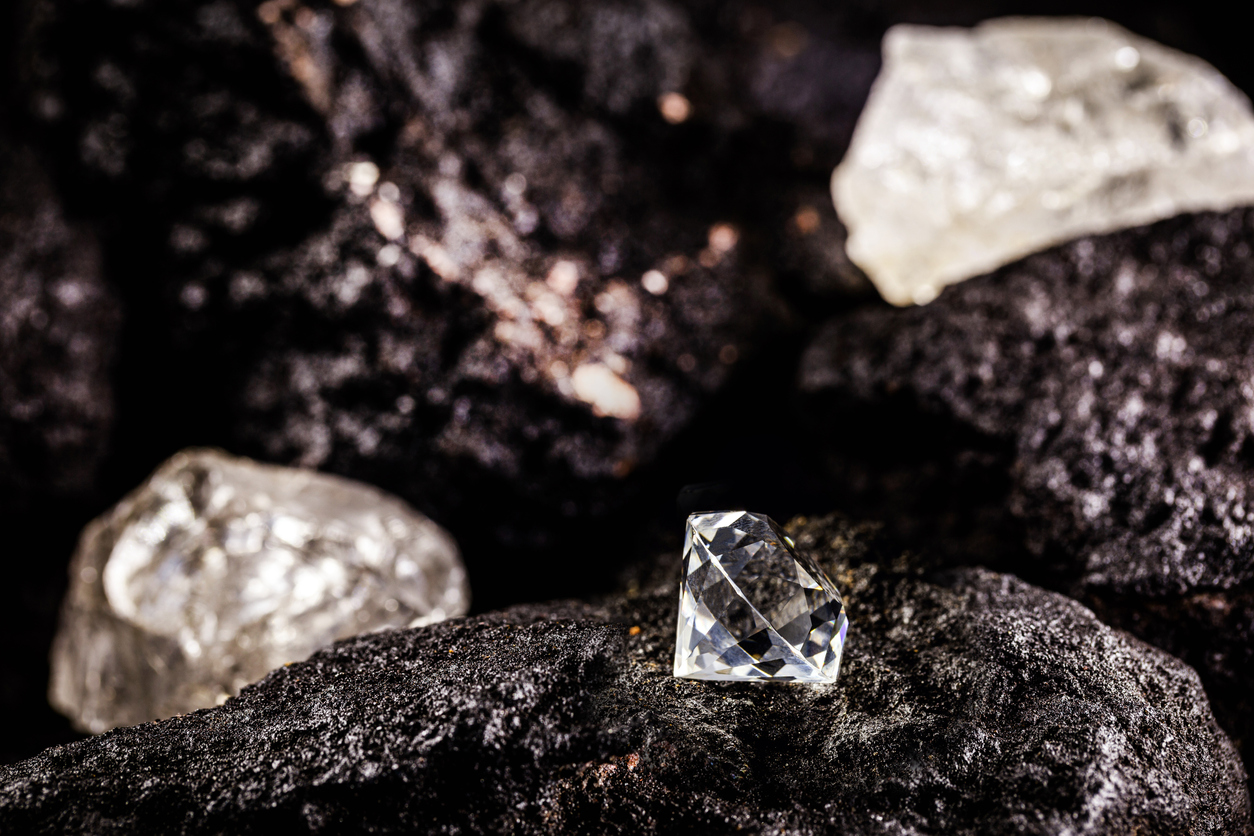
Lucara Diamond (TSX:LUC), a leading independent producer of exceptional quality type IIa diamonds, said on wednesday that the global market for diamond jewelry and rough diamonds is at one of the healthiest places it has been in several years.
The Vancouver-based miner believes it is a trend it can expect to see continue into 2022 as targets are being set accordingly. These positive market changes were spurred on by an improvement in global supply and demand fundamentals, Lucara said in a statement.
Lucara anticipates producing up to 340,000 carats which are planning to be sold through its multi sales channel approach and could generate revenues up to between $185 and $215 million. The following 2022 year also marks the tenth year their 100% owned Karowe mine in Botswana has been in operation.
These figures do not include any estimated contributions of revenue from large, exceptional diamonds that have historically formed a regular part of Karowe’s production profile, the company said.
The Karowe mine, which actually means precious stone in the local Botswana language, began operations in 2012. It is one of world’s most well known producers of large, high quality, Type IIA diamonds, mostly 10.8 carats, including the famous and historic 1,758 Sewelô, the 1,109 carat Lesedi La Rona and the 813 carat Constellation.
The only other major diamond ever unearthed at that site was discovered in South Africa in 1905, the Cullinan Diamond. The huge diamond was then cut into smaller stones, and some were even placed in the British royal family’s crown.
“The business environment for diamonds and diamond jewelry is the healthiest we’ve seen in several years,” CEO Eira Thomas said in the statement.
Big Names With Big Prices
The diamond market faced some difficulties over the last year due to the global COVID-19 pandemic, with some folks having increasing concerns that the market may take years to recover. However, intermediaries who polish, cut and trade stones seem to be purchasing every miner’s supply, even as big names such as Alrosa and Anglo American’s De Beers raise their prices.
According to the company website, over 6,900 diamonds of +10.8 carats have been discovered, as well as 25 +300 carat diamonds and three huge +1000 carat diamonds. The forecast for 2022 revenue assumes that 100% of the stones and carats recovered will come from the higher value M/PK(S) and EM/PK(S) units within the South Lobe, which is in accordance with their mine plan.
Diamonds that have a higher value than +10.8 will continue to enter the manufacturing pipeline at HB, allowing the company to gain exposure to polished prices and regular cash flow as these larger diamonds are of the highest value.
Open-pit operations will finish by 2026 at Karowe, however, Lucara also has an underground mining expansion project that was supported by the completion of a supplemental debt financing package in 2021. The company says it was a “significant de-risking milestone” for themselves and the mine.
“The underground expansion at Karowe provides access to the richest portion of the orebody and will extend mine life to at least 2040. The project remains on schedule and budget, with a forecasted spend of up to $110 Million in 2022,” Thomas said in the statement.
The underground expansion will focus on the commencement of shaft sinking activities, the commissioning of power, and detailed engineering for the underground development. Sustaining capital and project expenditures are expected to be up to $17 million with a focus on completion of a community sports facility, dewatering activities, and an expansion of the tailings storage facility, the company said.
BMO Capital Markets analyst Ray Raj touched on the importance of the future of the expansion, saying “the continued recovery of the significant high-value stones from the South Lobe further highlights the importance of the Karowe underground expansion.”
Thomas touched on the underground expansion updates in a previous press release, saying “These developments have significantly de-risked Lucara’s outlook on growth and has positioned the Company to benefit from a stronger, more stabilized diamond price environment as global rough diamond supply remains constrained.”
The decision to move the Karowe mine underground comes after Botswana renewed Lucara’s mining license in early January for another 25 years. The total cost of moving the mine is around $514 million and will take about five years to complete and extend the mine’s life up to 20 more years.
Next year, Lucara expects to process 2.6 million to 2.8 million tonnes of ores, which should yield between 300,000 and 340,000 carats.
Lucara owns 100% of the Karowe mine in Botswana and owns 100% interest in Clara Diamond Solutions, a sales platform designed to bring the existing diamond supply chain digital and more accessible in the modern era.
Pushing Digital First
The company highlighted its digital sales platform in the statement as it continues to help the company grow and expand in terms of volumes traded and customer participation. Lucara plans to continue platform trials and discussions with third-party suppliers of rough diamonds to build supply.
“The rationale for a web-based digital sales platform for the transaction of rough diamonds has never been stronger, sparked by industry’s need for increased transparency, global restrictions on travel, and a new openness to the use of innovation and technology to create a more efficient supply chain,” Thomas said.
Quarterly tenders and regular sales through Clara, primarily for stones less than 10.8 carats in size will continue, consistent with the practise from previous years, the company said.
Although Lucara is optimistic about the diamond market going into 2022, DeBeer’s is experiencing the opposite of what Lucara is claiming. The world’s largest diamond miner by value reported on Wednesday it has sold $430 million worth of rough diamonds this month, compared to the $492 million in sales obtained in the previous cycle.
Lucara’s shares fell 4.6% in early trading in Toronto to C$0.62. The company has a market capitalization of about C$287 million ($226m).
The diamond miner is based out of Vancouver and was originally incorporated in 1981. In 2018, Lucara completed the acquisition of Clara, their digital sales platform that “uses proprietary analytics together with cloud and blockchain technologies to revolutionize and modernize the diamond sales process.”
Lucara issued 13.1 million shares to the former shareholders of Clara upfront along with equity payments totaling 13.4 million shares which become payable upon the achievement of performance milestones related to total revenues generated by Clara.
The company agreed to a profit-sharing mechanism whereby the founders and facilitators of the Clara technology, and management of Clara, will retain 13.33% and 6.67%, respectively, of the annual EBITDA generated by the platform, to a maximum of US$25 million per year, for 10 years.
Full Ownership Acquired by Rio Tinto
In other recent diamond news, Rio Tinto (ASX:RIO) just became the sole owner of the Diavik Diamond Mine in the Northwest Territories in Canada. The transaction follows a 19-month process prompted in April 2020 by Dominion Diamond Mines ULC filing for insolvency protection under the Canadian Companies’ Creditors Arrangement Act. The mine employs over 1100 employees, of which 17% are Northern Indigenous people, and in 2020 it produced 6.2 million carats of rough diamonds. Production is expected to finish in 2025.
The above references an opinion and is for information purposes only. It is not intended to be investment advice. Seek a licensed professional for investment advice. The author is not an insider or shareholder of any of the companies mentioned above.
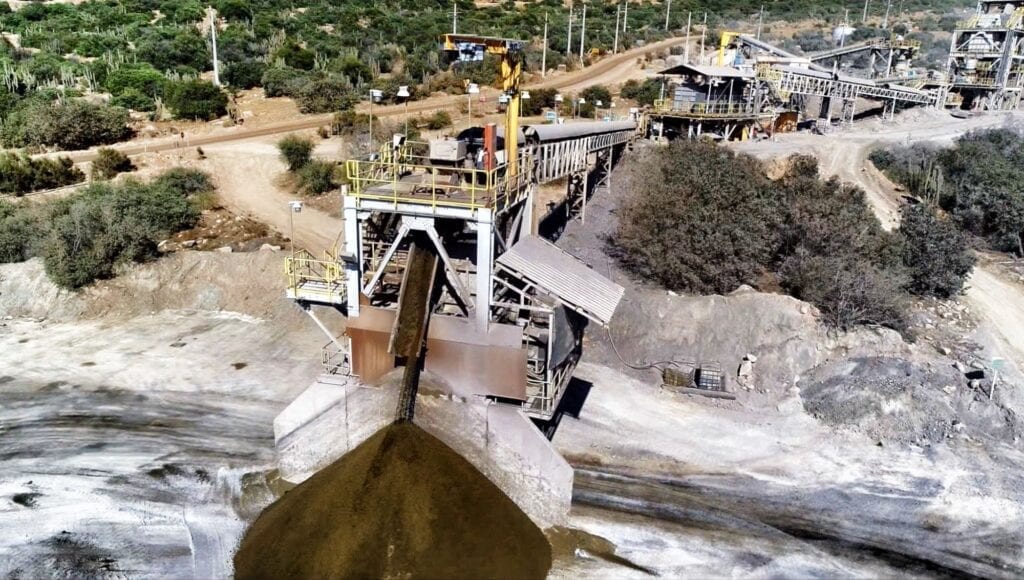
Three Valley Copper (TSXV:TVC) announced this morning that it had closed the previously announced bought-deal offering and exercise of the over-allotment option. The financing will help the company advance the Minera Tres Valles copper project in Chile, and fund exploration at the site. Additionally, funds will be used for working capital and general corporate purposes as Three Valley Copper explores, develops, and produces 99.99% copper cathodes at its flagship property.
Initially, the company entered into an agreement with co-lead underwriters and joint bookrunners PI Financial Corp. and Eight Capital for a C$10 million bought deal financing.
Then, shortly after, due to significant investor demand, PI Financial Corp and Eight Capital amended the agreement to increase the size of the deal.
Details of the financing are as follows:
The Company issued a total of 56,681,000 units (the “Units”) on a bought deal basis, at an offering price of C$0.32 per Unit (the “Offering Price”), which included 6,681,000 Units issued pursuant to the exercise of the over-allotment option, and issued 819,000 additional Common Share purchase warrants (each, a “Warrant”) pursuant to the exercise of the over-allotment option at an offering price of C$0.08 per Warrant, for gross proceeds of approximately C$18.2 million. Each Unit consists of one Class A common share (a “Common Share”) in the capital of the Company and one Warrant. Each Warrant entitles the holder thereof to purchase one Common Share at a price of C$0.45 for a period of 30 months following the closing of the Offering.
Source: Three Valley Copper
Michale Staresinic, CEO of Three Valley Copper (TSXV:TVC) commented in a press release: “This new equity capital coupled with the concessions provided by our senior lenders provide a roadmap for the Company to complete its flagship project at MTV, Papomono is on schedule to begin its first caving operations in January 2022 followed by an increasing production profile during 2022 and ultimately reach near production capacity in 2023. In parallel, we continue the strategic review process announced by the Company in October and welcome our new shareholders with the closing of this equity raise, and thank our existing shareholders for their ongoing support.
“With copper prices firmly above US$4 per pound for the majority of 2021, we continue to believe this level of price support for copper will continue in the long-run. The electric vehicle revolution, infrastructure stimulus spending, and world consensus on decarbonization back our strong conviction that our pure-play copper project with 46,000 hectares of underexplored lands will produce strong results for shareholders once we are able to reach production capacity. Our new shareholders see this too and we welcome their support through this Offering.”
The above references an opinion and is for information purposes only. It is not intended to be investment advice. Seek a licensed professional for investment advice. The author is not an insider or shareholder of any of the companies mentioned above.
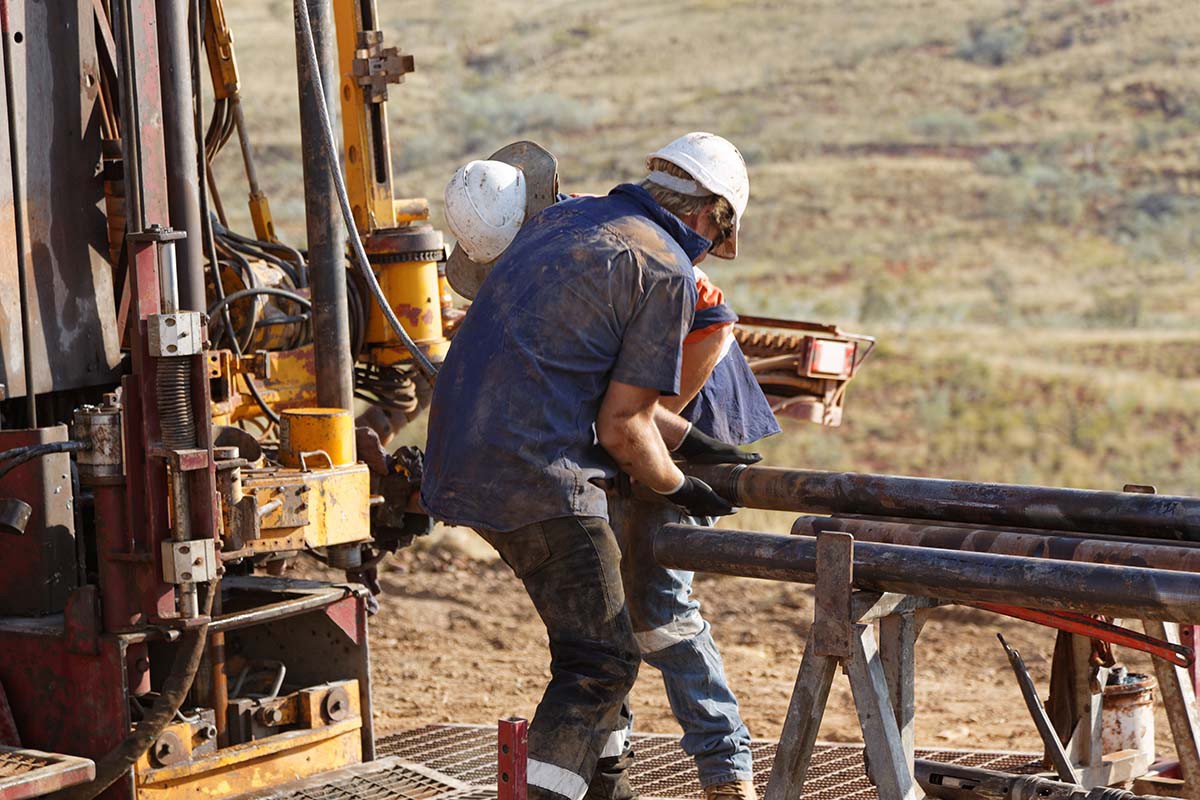
Novo Resources (TSX:NVO) announced last Friday that it will begin its brownfield exploration programs at its highly prospective Nullagine gold project located in the East Pilbara District of Western Australia.
The new exploration programs will focus on oxide opportunities at the Nullagine gold project with a 15,000 m reverse circulation drilling program which started at the Parnell-Vulture trend, also known as Parnell, during the first week of November 2021. This will take the company into the first quarter of 2022 as well.
Gold assay results from the new drill program are expected to be released by December 2021. Novo Resources has a priority arrangement with Intertek1 to provide PhotonAssay gold results.
Parnell-Vulture
Parnell is located about 45 kms from the Golden Eagle processing facility and can be accessed by an existing reliable haul road with surrounding infrastructure attached. Parnell covers a strike length of approximately 2 kms and contains a series of vein-hosted targets with historical drill intercepts.
The Parnell and Vulture reverse circulation programs are the first programs at the Nullagine gold project as things begin to ramp up, with forward programs currently being generated at several priority basement targets.
Novo has already conducted detailed mapping and gridded soil sampling at Parnell and Vulture to determine the mineralization potential, but has yet to acquire the necessary details to validate historical data. Once this information is acquired, it will serve as further confirmation and guidance for targets. However, significant rock samples from both Parnell and Vulture highlight the presence of high-grade gold targets, and further confirm the prospectivity of this area.
Multiple Projects on the Go
Novo’s primary focus is exploring and developing gold projects in the Pilbara region of Western Australia. It has several ownership interests across its 13,000 sq km land package, and has several different projects on the go.
Novo Resources’ main focus is its Egina gold project, where it is currently exploring and testing innovative exploration techniques under a JV with Japan’s Sumitomo Corporation. The company also has a 100% interest in the Purdy’s Reward gold project and a 100% interest in the production-ready Beatons Creek gold project.
The new drilling programs follow other recent news from Novo Resources (TSX:NVO) as its Golden Eagle processing facility or “Golden Eagle Mill” had restarted production at the beginning of November. The faculty underwent opportunistic maintenance as the company repaired its main crushing unit, which is now back online.
The above references an opinion and is for information purposes only. It is not intended to be investment advice. Seek a licensed professional for investment advice. The author is not an insider or shareholder of any of the companies mentioned above.

It was announced yesterday that Three Valley Copper Corp (TSXV:TVC) has entered into an undertaking between itself and its secured lenders of Minera Tres Valles, the Company’s primary asset that is 91.1% owned and located near Salamanca, Region de Coquimbo, Chile.
The company, with its direct and indirect wholly-owned subsidiaries including MTV and the lenders, have agreed to create a definitive binding agreement to revise the loan repayment schedule as set forth in the loan facility agreement.
Michael Staresinic, President and CEO of Three Valley Copper, said in a press release: “Our senior lenders continue to work as partners with us. This is an important first step in restructuring MTV’s debt obligations to improve cash flow from MTV in 2022 as we complete the development of the Papomono mine and ramp up production in 2022. Papomono is nearing completion and we remain on schedule to complete our first caving of ore in January 2022.”
Terms and conditions of the undertaking include the lenders agreeing not to accelerate or enforce their rights or remedies under the Facility Agreement if MTV were to fail to make scheduled loan repayments on March 31, 2022, June 30, 2022 and September 30, 2022 and/or replenish the operating reserve account to reestablish the Minimum Reserve as required under the Facility Agreement.
Also included in the conditions, the proceeds of the recently announced bought-deal financing of C$16 million will not be used to repay any of the loans outstanding under the Facility Agreement during the Forbearance Period. The Forbearance period is from November 22, 2021, to October 1, 2022. That financing was upsized from C$10 million after significant investor interest was expressed.
This undertaking follows the recent announcement to increase the size of the previously announced bought deal financing to an aggregate of 50,000,000 units of the Company at a price of C$0.32 per Unit. This is an excellent step forward with TVC’s partners and helps to secure financing that is expected to close later this week.
The above references an opinion and is for information purposes only. It is not intended to be investment advice. Seek a licensed professional for investment advice. The author is not an insider or shareholder of any of the companies mentioned above.
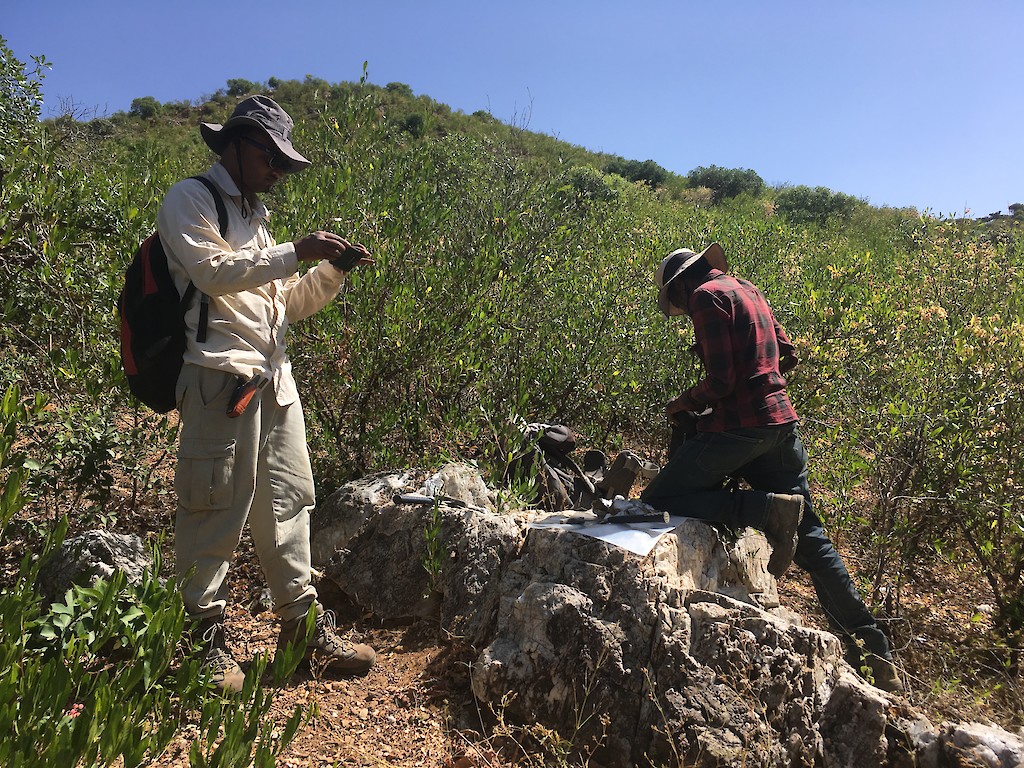
Mining royalty generator Altus Strategies has entered into an agreement to sell its 100% owned subsidiary Aterian Resources Ltd to Eastinco Mining and Exploration. Altus Strategies is a mining royalty generator based in the UK that focuses on generating a diverse portfolio of precious metals.
Altus has agreed to sell 100% of the Morocco-focused subsidiary to Eastinco, along with receiving up to 10% of additional warrants in Eastinco. It was also included in the agreement that Altus will be a shareholder of up to 25% of Eastinco, as well as having the option to let an Altus member join the Eastinco board. In addition, Altus will own 15 new royalties including a royalty on the Musasa tantalum mine in Rwanda.
Steven Poulton, Chief Executive of Altus said in a statement, “We are delighted to announce the proposed divestment to Eastinco of our 100% owned Moroccan focused exploration subsidiary, Aterian, as part of Eastinco’s proposed LSE Standard Listing and subsequent name change to Aterian Plc. The enlarged entity will have a strong and unique portfolio of strategic metal exploration and development projects in Morocco and Rwanda.”
Through this new agreement, Eastinco is planning to transform into a pan-African strategic metals development company, including a subsequent name change to Aterian Plc upon completion of the transaction.
Eastinco currently owns tantalum exploration and development projects in Rwanda. It is an investment company whose focus is on acquiring assets for the ethical exploration, development and trading of critical minerals across the African continent.
Charles Bray, Executive Chairman of Eastinco said in a press release: “I am delighted to report on this proposed acquisition of a significant portfolio of 15 copper, silver and other base metal exploration projects strategically positioned close to existing mining projects in Morocco. Upon completion, Altus will become a strategic shareholder of the Company, demonstrating Altus’ confidence in the projects, and providing us with an alignment of interest and the support of a well-respected industry player.”
Bray continued “Previous exploration undertaken by Altus on the Moroccan assets highlight the strong potential for the discovery of deposits of strategic metals in particular, copper and silver. We believe the market fundamentals for copper are excellent, specifically linked to the anticipated growing demand for renewable energy and the related electrification of transportation globally.”
The agreement still remains subject to certain conditions including the admission to trading of Eastinco’s entire issued share capital to the Official List of the FCA and to trading on the London Stock Exchange’s Main Market for listed securities.
“We consider this to be the optimal time to broaden and strengthen our asset portfolio across Africa, adding to our established tantalum mining and exploration projects in Rwanda. Our working relationship with Altus will also guarantee a smooth transition to ensure exploration continues in Morocco without interruption. Our proposed LSE Standard Listing will provide us with exposure to a wider investor profile and greater liquidity in our shares and, therefore, a solid platform from which we can continue to grow,” Bray said.
Charles Bray believes this is a key step to becoming a leading strategic metal exploration and development company in Africa.
“We look forward to the completion of the acquisition, the successful Admission of Eastinco, and to supporting the Eastinco team going forward,” Poulton concluded.
The above references an opinion and is for information purposes only. It is not intended to be investment advice. Seek a licensed professional for investment advice. The author is not an insider or shareholder of any of the companies mentioned above.
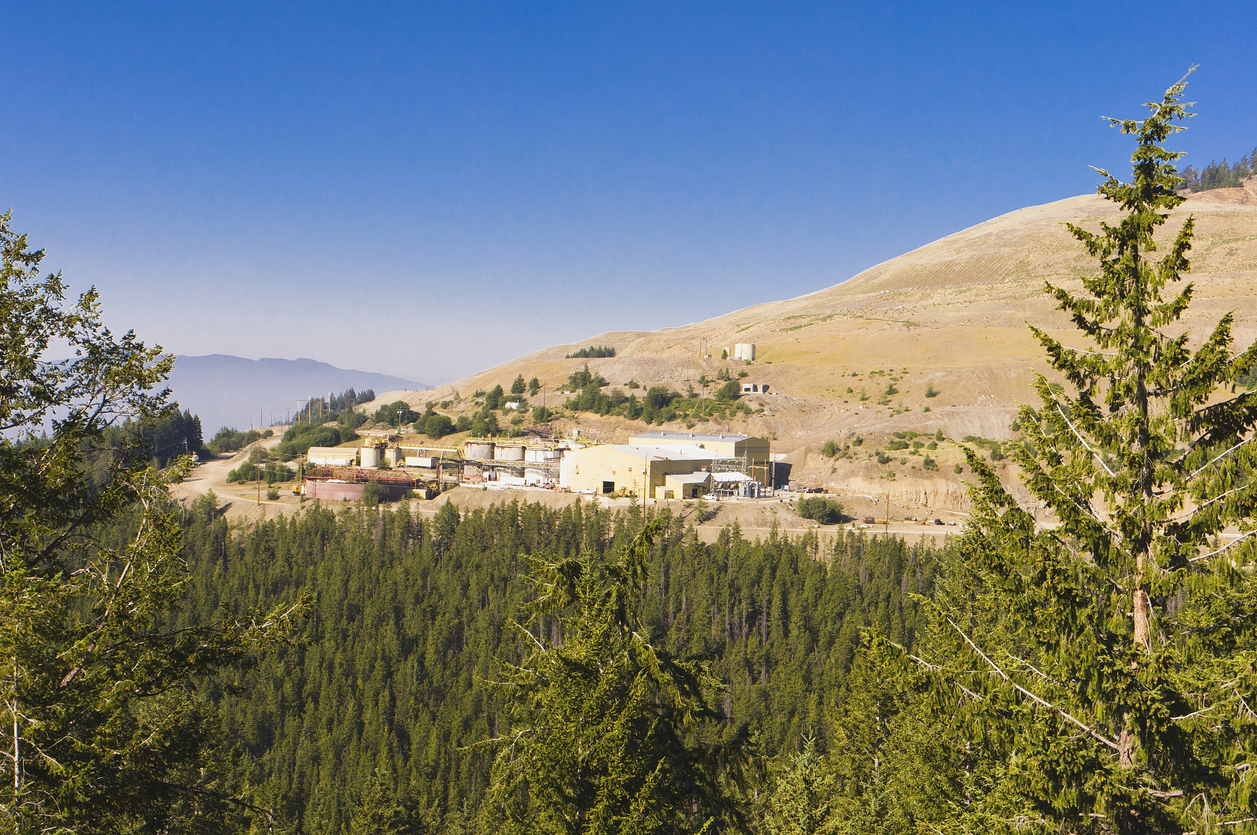
Canada Nickel announced that through 18 separate and concluded transactions, it has acquired or been granted earn-in to 13 additional target properties within a radius of 95 km of the company’s flagship Crawford Nickel-Sulfide Project in Ontario.
The acquisition consolidates Canada Nickel’s position in the Timmins area, as the company sees high potential for future endeavours in the region.
“The acquisition of these highly prospective target properties represents a transformational milestone for Canada Nickel, on par with the initial discovery of our flagship property, Crawford. The consolidation of these properties underscores our strong belief in the district-scale potential of the Timmins region and in our journey to become a leader of the Next Generation of Nickel Supply – large, scalable, low carbon nickel supply,” said Mark Selby, Chair & CEO of Canada Nickel in the statement.
Each of the properties is said to contain one or more ultramafic targets based on combinations of historical geophysical work and drilling over the past 65 years. The 13 new properties have a combined target surface of 37.7 square km, which is 40 times larger than the current Crawford Main Zone resource of 0.85 square km.
Ten of the target properties have a larger footprint than Crawford and nine are confirmed to contain the same host mineralization as Crawford, a proposed open-pit mine and mill that will produce both nickel and magnetite concentrates.
The Sothman target property was highlighted by Canada Nickel for having a historical higher grade, with a shallow resource of approximately 190,000 tons of 1.24% nickel. Sothman is a property of approximately 1,000 ha located 70 km south of Timmins and was acquired by Glencore.
They also highlighted that four target areas have yielded drill intersections of nickel including Sothman, Deloro, Midlothian, and Mann Southeast.
“We’re talking district-scale potential that would make this the largest base metal mine in Canada once it’s ramped up,” Selby said in an interview back in May. “We’d be the largest single nickel sulphide mine in the world outside Russia. We’ll be bigger than [Vale’s] Voisey’s Bay. This is a pretty significant project.”
The 18 properties were negotiated through all separate agreements and Canada Nickel will pay a combined $371,500 in cash and 2,044,000 shares, in which $25,000 has already been paid and 125,000 shares have already been issued.
One of the main goals of the company is working towards developing a process for production of net-zero carbon nickel, cobalt, and iron products using technology from its wholly-owned subsidiary NetZero Metals.
The plan is to use existing methods and alternatives to help reach this goal rather than creating new tools and equipment, such as electric rope shovels and trolley trucks that use electricity rather than diesel whenever they can. A natural mineral carbonation approach for the deposition of waste rock and tailings during mining to allow material to absorb CO2 is another alternative they plan on implementing.
Turning into a zero-emissions nickel producer could also grab the attention of Elon Musk, co-founder and CEO of Tesla. The electric vehicles maker claimed last year that he would give any big firm that can extract the metal in an environmentally friendly manner a giant contract for a long period.
The above references an opinion and is for information purposes only. It is not intended to be investment advice. Seek a licensed professional for investment advice. The author is not an insider or shareholder of any of the companies mentioned above.
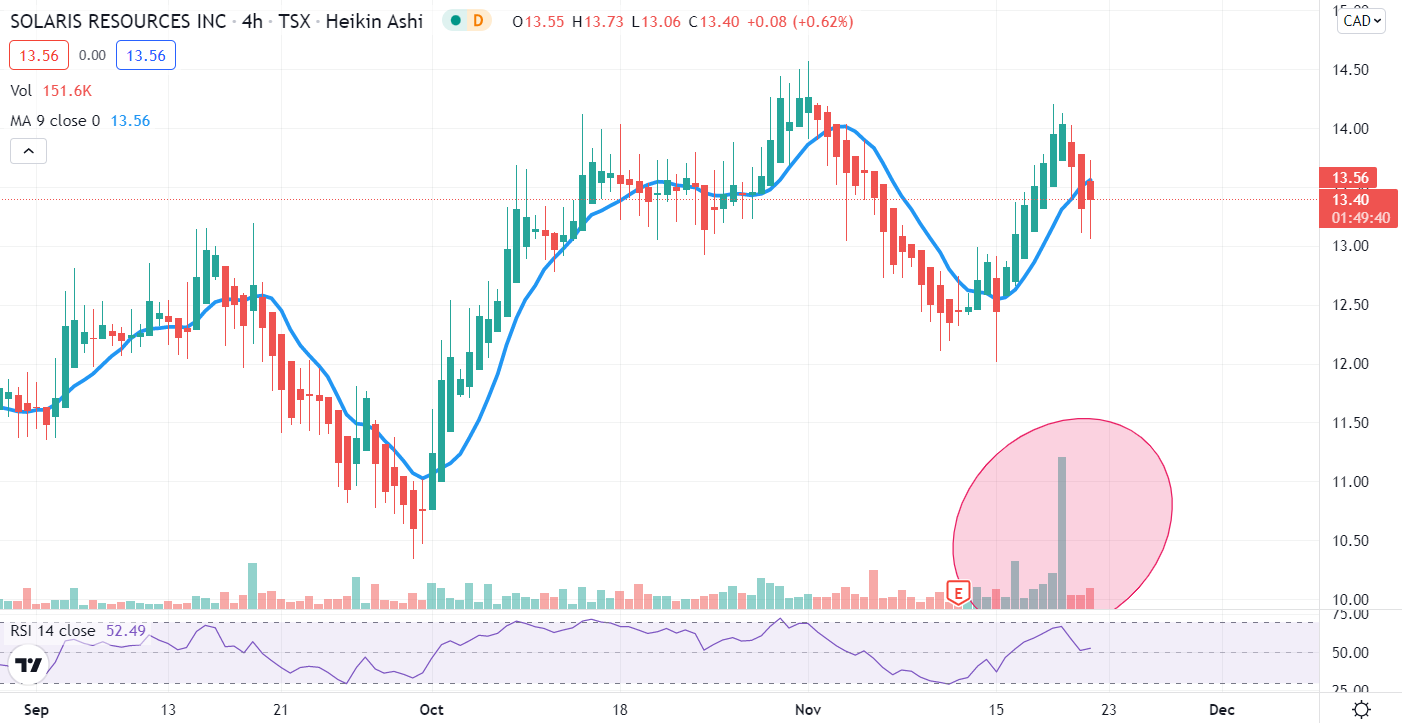
On November 18, 2021 Solaris Resources (TSX:SLS) traded above average volume by hundreds of thousands of shares at nearly 1.7 million in daily volume. Solaris’ share structure has one of the highest insider ownerships for a junior miner, begging the question of why exactly did volume spike on that day?
Could it have been that insiders are shifting positions ahead of upcoming drill results? Or is something else happening with retail investors to draw such high volume?
It would first help to understand what a breakout above regular price action and traded volume can mean for investors. Often higher volume will drive prices higher or lower depending on the bid-ask spread, but in this case, shares traded only 2% higher on the day.
The stock was not outside of its normal bounds, and closed just below C$14, at $13.90. The uptick in volume is notable for how it didn’t accompany a significantly different price action, but potentially foreshadows new price action coming down the line.
For this reason, it could be inferred that the expectation of news coming down the pipeline could be the reason for the higher than average daily volume. The company has had a run of successful assay results as part of its ongoing exploration at the Warintza Project in Ecuador.
An expansion of the Warintza Porphyry Cluster, multiple back-to-back discoveries, the commencement of maiden drilling at Warintza South, and positive preliminary results at Warintza Central have seen shares climb consistently month after month.
The stock is up over 1000% since the company’s IPO in 2020, and the bullish sentiment indicated by multiple breaks above the 50-day moving average would seem to indicate that buyers are always present.
Whether the larger than average trade volume is indicative of insiders moving shares ahead of news or higher investor interest due to the company’s performance and the drill program is yet to be seen. For now, investors will be watching closely whether Solaris (TSX:SLS) continues to climb higher.
The above references an opinion and is for information purposes only. It is not intended to be investment advice. Seek a licensed professional for investment advice. The author is not an insider or shareholder of any of the companies mentioned above.
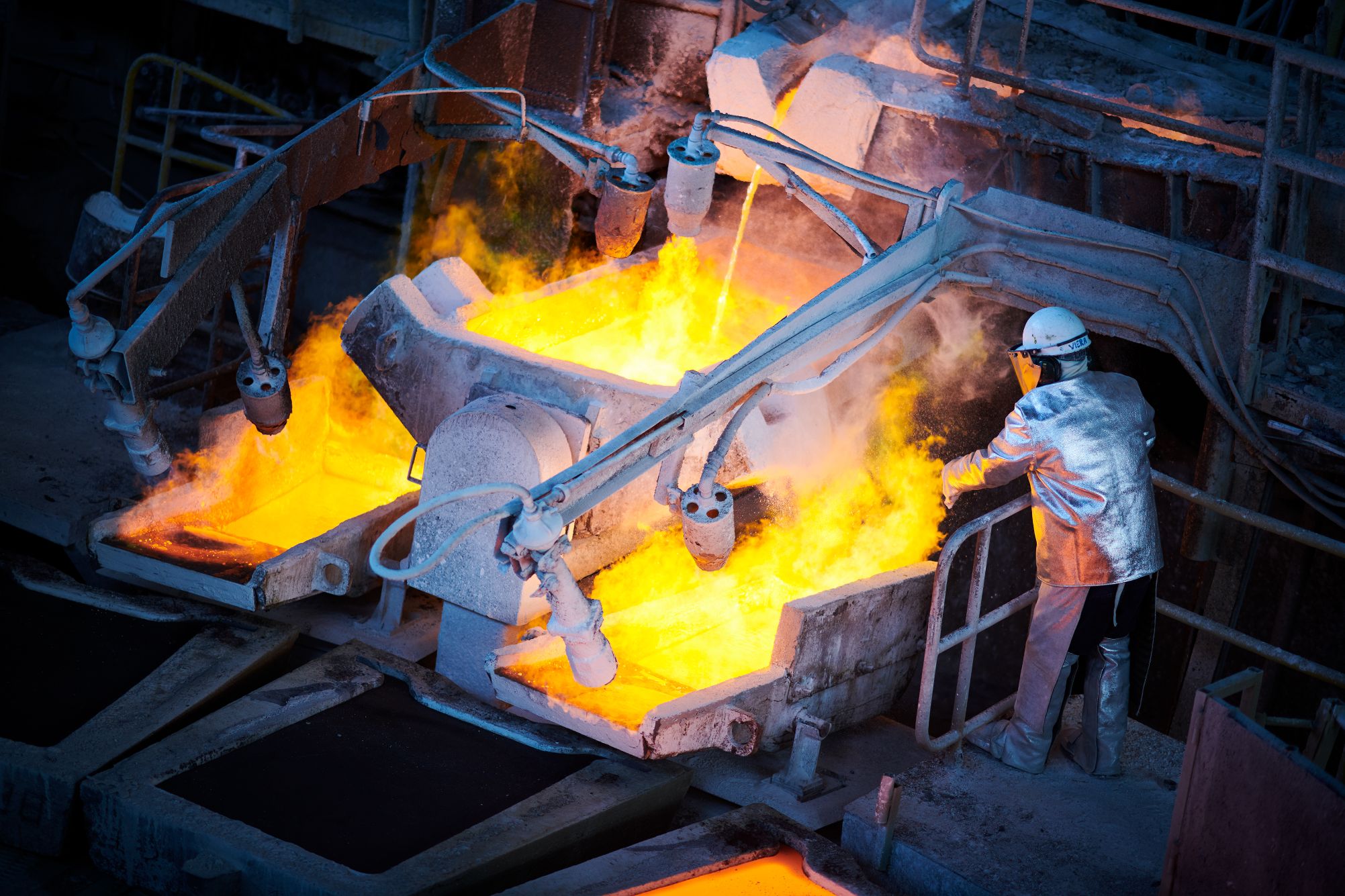
Evolution Mining (ASX:EVN), based in Australia, is a globally recognized gold miner. On October 5, 2021, the company acquired the Ernest Henry Mining (EHM) copper and gold mine in Queensland, Australia, from Glencore (LON:GLEN) for $729.60 million (A $1 billion).
Ernest Henry includes an underground mine that produces copper and gold concentrate that is transported to Mount Isa Mines for smelting.
Evolution acquired the company $582 million (A$800 million). After completion of 12 months, a further A$200 million will be paid. Evolution had previously acquired an economic interest in Ernest Henry in 2016 through a joint structure, with the asset managed and operated by Glencore. This new deal brings the Ernest Henry Mine under Evolution’s control and ownership. Evolution is now the sole owner of the asset so it will assume full ownership of its operations as well.
An Exit for One of the World’s Largest Natural Resource Companies
Glencore is one of the world’s largest diversified natural resource companies, as well as a major producer and marketer of more than 60 commodities. In Australia, Glencore produces coal, copper, cobalt, nickel, zinc, lead, silver, and gold between 26 mining operations. Glencore is also one of the country’s biggest employers.
Glencore employs approximately 17,700 people in Australia (including around 600 at the Ernest Henry Mine) and in 2020 the company contributed more than $13.8 billion to the regional, state, and national economies.
Glencore CEO Gary Nagle said in a statement, “Evolution has been a strong partner at Ernest Henry Mine for five years. They share our way of working and our commitment to operating responsibly in all aspects of the business.”
Glencore’s commitment to northwest Queensland will continue with the Mount Isa Mines copper and zinc complex, copper smelter, and Townsville copper refinery. Glencore will also pivot from this mine and increase its focus on lower-cost, long-life copper assets in its global portfolio, such as those in Africa and South America.
Shares of Evolution Mining Ltd (ASX: EVN) were up nearly 8% on the day of the announcement.
An Effort to Boost Production
The company advised that the acquisition will increase its copper production from its previous forecast to between 34,000 and 38,000 tons and reduce its all-in sustaining cost (AISC) to around A$90 to A$100 per ounce. This will help cement it as one of the lowest-cost gold producers in the world.
The recent acquisition aligns with Evolution’s strategy of investing in assets with immediate material increase in cash flow generation.
Once the initial $800 million round of the transaction is completed, Evolution will have about $900 million in liquidity available at settlement, the release noted.
Evolution Mining’s CEO said, “We have long coveted ownership of Ernest Henry. It is a world-class asset, in Australia, and one we know extremely well due to our successful investment in the asset in 2016 and we are proud that it will once again be 100% Australian. The acquisition is consistent with our strategy, substantially improves the quality of our portfolio and offers both strong cash flow and life-of-mine extension opportunities.”
He continued, “The site management team has an outstanding track record of operational delivery and we are delighted to have them join Evolution and look forward to working with them to make this an even better operation. We are also pleased to continue our strong relationship with Glencore and that product will continue to be treated in the local region at their Mt Isa smelter and Townsville refinery.”
The above references an opinion and is for information purposes only. It is not intended to be investment advice. Seek a licensed professional for investment advice. The author is not an insider or shareholder of any of the companies mentioned above.
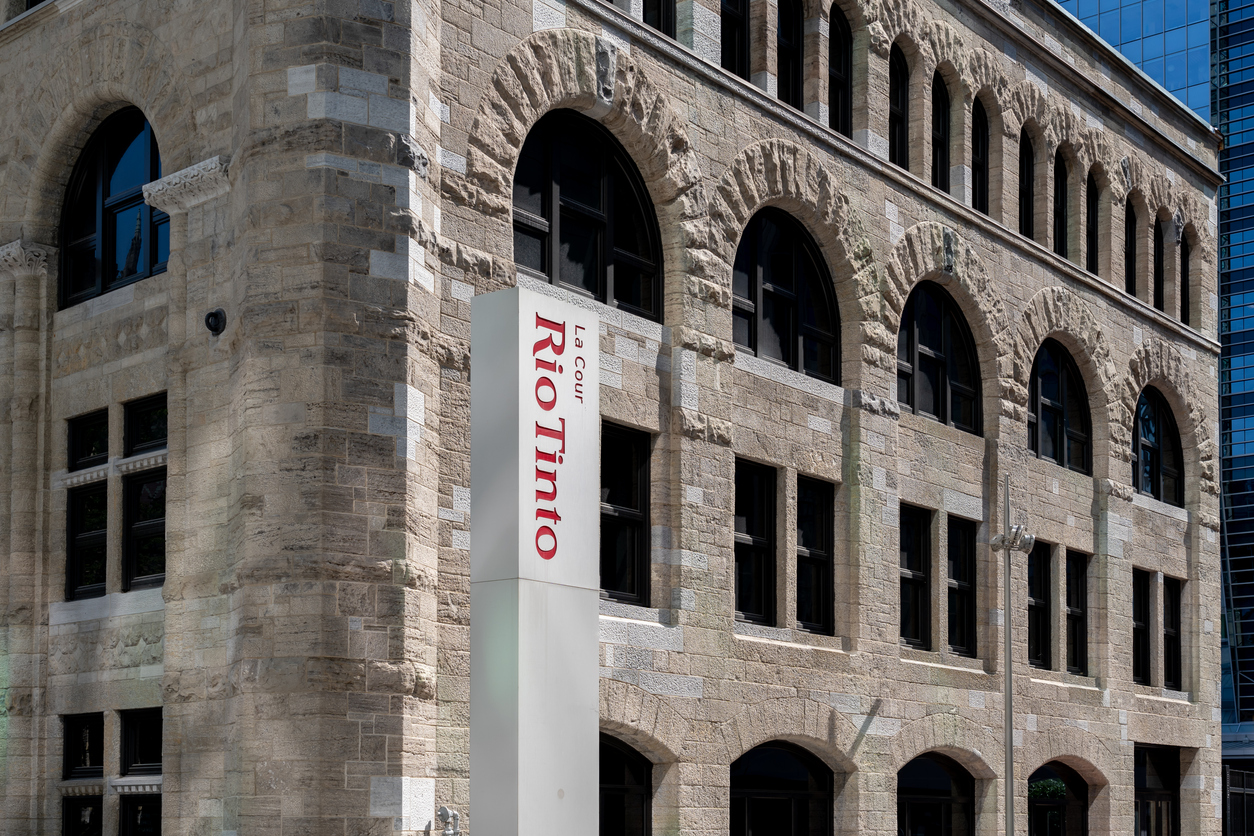
Rio Tinto (ASX:RIO), the world’s second-largest miner, just became the sole owner of the Diavik diamond mine in Canada’s Northwest Territories on Thursday. Despite saying in the past the Company was not interested in taking full control of the aging arctic mine, Rio Tinto ended up buying the 40% share held by Dominion Diamond Mines for a total stake of 100%.
Part of the transaction includes Rio Tinto releasing Dominion and its lenders from any outstanding liabilities or obligations involving funding the operation or the closure of the joint venture. On the other end, Rio Tinto will receive all remaining Diavik assets held by Dominion including a security cash collateral for the potential future closure for the mine and unsold production.
Why the Buyout Now?
Dominion, which used to be the fourth-largest diamond producer, suffered some financial troubles which played out in court over several months last year. These troubles ultimately led Dominion to sell its other Canadian mine, Ekati in December 2020. In 2017, The Washington Companies ended up buying the Company for $1.2 billion.
This deal follows a 19 month long process beginning in April 2020 by Dominion Diamond Mines filing for insolvency protection under the Canadian Companies’ Creditors Arrangement Act.
Diavik has been in production since 2003 and is eventually facing closures in 2025 which will cost hundreds of millions of dollars to fully clean up. Diavik is Canada’s largest diamond mine, and yielded 6.2 million carats of rough diamonds in 2020.
Rio Tinto Minerals boss Sinead Kaufman said in a statement, “Diavik will now move forward with certainty to continue supplying customers with high quality, responsibly sourced Canadian diamonds.”
Worries and concerns began to surround the diamond market due to production coming to a
halt during the global COVID-19 pandemic, with some people worried the market would never recover. However, Alrosa, the world’s top diamond miner by output, claims the market has fully recovered from the effects of the global pandemic, and sales of jewelry and rough diamonds are up 23% this year compared to 2020.
Rio Tinto Invests US$87 Million to Boost Low-Carbon AP60 Aluminum Production
In other recent news, Rio Tinto (ASX:RIO) decided to invest US$87 million in order to increase capacity at its Canadian low-carbon aluminum production project. The company is creating 16 new smelting cells in the Saguenay-Lac-Saint-Jean region of Quebec at its AP60 smelter in the which will increase the production by about 45%, or 26,500 metric tonnes of primary aluminum per year.
This will increase capacity up to 86,500 metric tonnes. Not only will production increase, but this upgrade will secure the futures of up to approximately 100 employees who work at the smelter by extending the life of the project.
Rio Tinto Aluminium chief executive Ivan Vella commented: “Rio Tinto is committed to strengthening its position as a leader in low-carbon, hydro-powered aluminum production to meet the clear demand from our customers in North America and Europe. Our AP60 technology is one of the most energy-efficient, environmentally friendly and cost-effective systems in commercial production today. It produces some of the world’s lowest carbon aluminum with renewable hydropower here in Quebec. We are assessing options for further investments, as we progress development of the ELYSIS zero-carbon smelting technology with our partners.”
Rio Tinto predicts the aluminum market will grow at an average rate of about 3.3% per annum over the next decade as strong demand for the metal comes from green energy transition and decarbonization.
The AP60 technology building generates seven times fewer greenhouse gases than the average building in the industry and was created by Rio Tinto’s research and development teams. Since 2013, the initial AP60 technology pots have produced more than 465,000 tonnes of low-carbon aluminum.
The new work will begin in 2022 and should be completed by the end of 2023. The new pots will be built in the existing building of the Complexe Jonquière’s AP60 technology centre, which currently has 38 pots. As the new pots are being built, Rio Tinto will also be looking into potentially installing AP60 cells at the site in the future.
The above references an opinion and is for information purposes only. It is not intended to be investment advice. Seek a licensed professional for investment advice. The author is not an insider or shareholder of any of the companies mentioned above.

U.S. President Joe Biden and President Xi Jinping of China held a virtual summit, and the leaders of the world’s two largest economies faced tensions over trade, cyber threats, climate, and human rights.
Investors applauded the meeting between U.S. President Joe Biden, and Chinese leader, Xi Jinping, due to positive developments that favored the rise in copper prices.
Copper prices rose as the dollar weakened, leading to an improved risk sentiment among investors.
Three-month copper on the London Metal Exchange was up 0.4% at $9,711.50 a tonne at the same time as the most-traded December copper contract on the Shanghai Futures Exchange rose 0.2% to 71,070 yuan (11,154.01) a tonne.
The dollar retreated broadly against riskier currencies in early trading. It recovered slightly to hold near a 16-month high against the euro ahead of U.S. retail sales data, which could influence the outlook for interest rates.
A weaker dollar makes dollar-priced metals cheaper for other currencies.
Meanwhile, thanks to traders welcoming a dialogue between the U.S. and Chinese presidents, the yuan rose to a five-month high as the conversation between the two presidents appeared to be off to an amicable start.
“Old Friend”
Biden and Xi emphasized their responsibility to the rest of the world to avoid conflict. During the conference held via a virtual phone call, Xi called Biden an “old friend” emphasizing improved communication and cooperation between the two countries.
The two leaders have agreed to hold talks on their nuclear arsenals, having discussed their need for “strategic stability.” The move suggests that the United States is taking the nuclear threat posed by China more seriously.
The U.S. and China also reportedly discussed during their call a coordinated action to release strategic oil reserves in order to lower prices.
U.S. officials have been pressing their Chinese counterparts to close the gap on promised purchases of U.S. energy, agricultural products, and medical devices to improve other areas where China has not lived up to its trade commitments to respect intellectual property provisions.
A Rising Tide
While commodities were up broadly across the market, copper was up significantly more than the rest. While President Xi Jinping did not join other world leaders for the COP26 conference, it is clear that China’s participation in the summit with President Biden is a step in the right direction.
China has attempted to cool copper and other commodity prices by releasing state reserves to the market, to no avail. Prices continued to rise even after the reserves were released, following a slight drop in prices as traders adjusted.
Inventories on the LME are low, and shipping and other logistical backlogs are creating problems for deliveries for key metals and minerals. For now, the inventory issue will need to be solved in the short term, with future copper projects brought online faster than currently forecasted to keep up with demand.
The above references an opinion and is for information purposes only. It is not intended to be investment advice. Seek a licensed professional for investment advice. The author is not an insider or shareholder of any of the companies mentioned above.

Collective Mining (TSXV:CNL) announced on Monday that their follow-up drilling on the recent grassroots discovery at the Donut target intercepted long and continuous zones of mineralization from the surface. The Donut target is at the Guayabales project in Colombia and is the first out of five outcropping and grassroot targets generated by the Company to be drill tested.
The company currently has two diamond drill rigs on site as part of its maiden 10,000 metre drill program with a third rig to be added in early Q1, 2022.
Ari Sussman, Executive Chairman of Collective Mining, commented: “We are absolutely thrilled with the results of the first five drill holes into Donut, which is a complete virgin grassroots discovery. Importantly, the results mark an important step in our vision of once again untapping the enormous geological potential of Colombia by discovering the next large-scale deposit in the country. The first ever drill hole is now advancing in the Box target and later this month, we will begin drilling our maiden hole into the Olympus target.”
Highlights from the press release are as follows:
- Broad and continuous gold (“Au”) and silver (“Ag”) mineralization hosted predominately in breccia has been intersected from surface in diamond drill holes DOC-3 and DOC-4 at the Donut target as follows:
- Drilled to the north, DOC-3 intercepted 163 metres at 1.3 g/t gold equivalent from surface including 2 metres at 83.2 g/t gold and 37 g/t silver from 155.6 metres depth; and
- Drilled steeply to the southwest, DOC-4 intercepted 260 metres at 0.6 g/t gold equivalent from surface including 69 metres @ 0.9 g/t gold and 8 g/t silver from 183 metres depth (DOC-4).
- DOC-5, which was drilled to the southeast, intersected a narrower interval of mineralized breccia before passing through a fault. Upon exiting the fault at 81 metres down-hole, late phase (lower grade) porphyry style mineralization was encountered over a significant interval as follows:
- 275 metres at 0.2 g/t gold, 5 g/t silver, 0.07% copper from surface.
- Donut is located at the NW end of a SW trending zone of outcropping breccia mineralization which, to date, has been traced to the SW for 550 metres along strike and remains open for further expansion to the SW.
“Potassic altered diorite porphyry overprinted by phyllic assemblages and sulfide cemented breccia dominate Donut drill holes. Banded quartz-magnetite veins cutting diorite porphyry at depth and as common clasts in breccia at shallower levels indicates excellent potential to discover a large porphyry system nearby the existing new breccia discovery at Donut,” commented Dick Tosdal, Special Advisor to Collective Mining and world-renowned expert on porphyry systems.
This intercept confirms that a porphyry system exists in the Donut target area. In order to better pinpoint a potential location for a concealed well-mineralized porphyry, a special survey is planned and once that is completed there will be follow-up additional diamond drilling.
Drilling was recently completed for holes DOC 6 through DOC 10 and samples were sent to the lab for analysis. Additional assay results are expected in Q4, 2021.
Figure 1: Plan View of the Guayabales Project and the Donut Target is available at https://www.globenewswire.com/NewsRoom/AttachmentNg/73fc402b-5fb4-451b-85d0-e3ae439b457d
Figure 2: Plan View of the Donut Target Area is available at https://www.globenewswire.com/NewsRoom/AttachmentNg/45408cf8-9286-4069-a56a-e7e73836c984
Figures 3: Drill Core Photos are available at:
DOC-3: https://www.globenewswire.com/NewsRoom/AttachmentNg/c796b708-f7c3-44f9-99fb-524f1eba9b9b
DOC-4: https://www.globenewswire.com/NewsRoom/AttachmentNg/e386c984-4141-4fc7-811f-e39c728c87d4
DOC-5: https://www.globenewswire.com/NewsRoom/AttachmentNg/9c3290f1-f9cf-4c16-8855-d5e1ba0be905
The above references an opinion and is for information purposes only. It is not intended to be investment advice. Seek a licensed professional for investment advice. The author is not an insider or shareholder of any of the companies mentioned above.
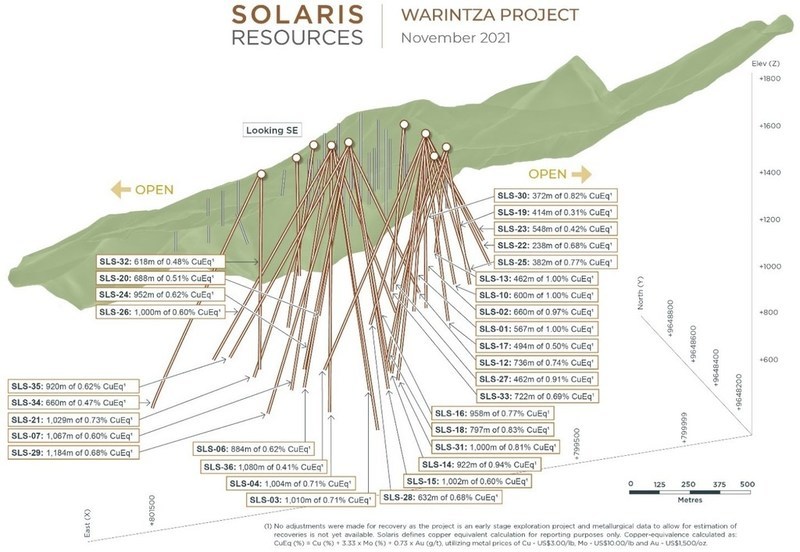
Solaris Resources (TSX:SLS) announced this morning its assay results from a set of additional holes from ongoing resource growth and discovery drilling programs at the Warintza Project in southeastern Ecuador.
Vice President, Exploration Mr. Jorge Fierro, commented: “We are pleased to see the continued growth of the Warintza Central zone, with every hole drilled having hit significant mineralization and the dimensions of the zone open and growing to the east, and broadening to the north and south where additional assays are expected soon. Our drilling fleet has now been fully reoriented to pursue aggressive growth and discovery drilling over the balance of the year and into 2022.”
The highlights from the project are as follows:
- Two additional holes reported in this press release have extended the dimensions of Warintza Central zone to the south and east, with the highest-grade intervals in each hole starting at or near surface
- Southern extension drilling in SLS-36 together with northern step-out drilling previously reported on October 12 in SLS-32, which returned 618m of 0.48% CuEq¹ from surface, including 372m of 0.64% CuEq¹ from 46m depth, have widened the Warintza Central zone
- SLS-35 was collared at the southeastern limit of the Warintza Central grid and drilled into a partially open volume to the east, returning 920m of 0.62% CuEq¹, including 326m of 0.80% CuEq¹ from 50m depth, extending mineralization to the east where it partially overlaps Warintza East
- SLS-36 was collared in the middle of the Warintza Central grid and drilled into an open volume to the southeast, returning 1,080m of 0.41% CuEq¹ from surface, including 290m of 0.81% CuEq¹ from 46m depth, extending mineralization by at least 200m to the south where it remains open
- To date, 50 holes have been completed at Warintza Central with assays reported for 36 of these
Source: Solaris Resources
Future drilling will be focused on extensional and step-out drilling. This includes establishing the potential link to the Warintza East zone, discovery drilling at the other well-defined targets within the 7km x 5km Warintza cluster of copper porphyries, and focusing on the untested gold potential.
Drilling Continues in Harmonious Alliance
A strategic alliance was made between Solaris and the Shuar communities of Warints and Yawi in 2019 to overlook and engage in direct and transparent dialogue regarding all Warintza Project-related activities. This alliance allows the people of the community to build and promote trust, reciprocal support, cooperation and strengthen the decision-making capacity of the community. It allows them to have a voice in their community when direct change is taking place.
The company states the mandate will include but not be limited to positive results including employment, business development opportunities, appropriate health care, and emergency care services, development of community infrastructure, and education and skills training.
The Warintza Project is situated in southeastern Ecuador, in the same belt as the Fruta del Norte and Mirador mines, adjacent to San Carlos – Panantza copper deposits. Solaris Resources also has four other current gold and copper projects, including La Verde in Mexico in which Solaris has earned a 60% interest via JV with Teck Resources.
There is also the Tamarugo in Chile which is an undrilled, grassroots copper porphyry exploration target in the Chilean copper belt, and the Capricho Paco Orco in Peru which is a Grassroots exploration project. The final project is Ricardo in Chile, it is a brownfield copper porphyry exploration project immediately contiguous and on the same structure as Chuquicamata, one of the largest copper mines in Chile.
Table 1 – Assay Results
|
Hole ID |
Date Reported |
From (m) |
To (m) |
Interval (m) |
Cu (%) |
Mo (%) |
Au (g/t) |
CuEq¹ (%) |
||
|
SLS-36 |
Nov 15, 2021 |
2 |
1082 |
1080 |
0.33 |
0.01 |
0.04 |
0.41 |
||
|
Including |
46 |
336 |
290 |
0.67 |
0.03 |
0.08 |
0.81 |
|||
|
SLS-35 |
48 |
968 |
920 |
0.53 |
0.02 |
0.04 |
0.62 |
|||
|
Including |
50 |
376 |
326 |
0.69 |
0.02 |
0.05 |
0.80 |
|||
|
SLS-34 |
Oct 25, 2021 |
52 |
712 |
660 |
0.36 |
0.02 |
0.06 |
0.47 |
||
|
SLS-33 |
40 |
762 |
722 |
0.55 |
0.03 |
0.05 |
0.69 |
|||
|
SLSE-02 |
0 |
1160 |
1160 |
0.20 |
0.01 |
0.04 |
0.25 |
|||
|
SLS-32 |
Oct 12, 2021 |
0 |
618 |
618 |
0.38 |
0.02 |
0.05 |
0.48 |
||
|
SLS-31 |
8 |
1008 |
1000 |
0.68 |
0.02 |
0.07 |
0.81 |
|||
|
SLS-30 |
2 |
374 |
372 |
0.57 |
0.06 |
0.06 |
0.82 |
|||
|
SLSE-01 |
Sep 27, 2021 |
0 |
1213 |
1213 |
0.21 |
0.01 |
0.03 |
0.28 |
||
|
SLS-29 |
Sep 7, 2021 |
6 |
1190 |
1184 |
0.58 |
0.02 |
0.05 |
0.68 |
||
|
SLS-28 |
6 |
638 |
632 |
0.51 |
0.04 |
0.06 |
0.68 |
|||
|
SLS-27 |
22 |
484 |
462 |
0.70 |
0.04 |
0.08 |
0.91 |
|||
|
SLS-26 |
July 7, 2021 |
2 |
1002 |
1000 |
0.51 |
0.02 |
0.04 |
0.60 |
||
|
SLS-25 |
62 |
444 |
382 |
0.62 |
0.03 |
0.08 |
0.77 |
|||
|
SLS-24 |
10 |
962 |
952 |
0.53 |
0.02 |
0.04 |
0.62 |
|||
|
SLS-19 |
6 |
420 |
414 |
0.21 |
0.01 |
0.06 |
0.31 |
|||
|
SLS-23 |
May 26, 2021 |
10 |
558 |
548 |
0.31 |
0.02 |
0.06 |
0.42 |
||
|
SLS-22 |
86 |
324 |
238 |
0.52 |
0.03 |
0.06 |
0.68 |
|||
|
SLS-21 |
2 |
1031 |
1029 |
0.63 |
0.02 |
0.04 |
0.73 |
|||
|
SLS-20 |
April 19, 2021 |
18 |
706 |
688 |
0.35 |
0.04 |
0.05 |
0.51 |
||
|
SLS-18 |
78 |
875 |
797 |
0.62 |
0.05 |
0.06 |
0.83 |
|||
|
SLS-17 |
12 |
506 |
494 |
0.39 |
0.02 |
0.06 |
0.50 |
|||
|
SLS-16 |
Mar 22, 2021 |
20 |
978 |
958 |
0.63 |
0.03 |
0.06 |
0.77 |
||
|
SLS-15 |
2 |
1231 |
1229 |
0.48 |
0.01 |
0.04 |
0.56 |
|||
|
SLS-14 |
0 |
922 |
922 |
0.79 |
0.03 |
0.08 |
0.94 |
|||
|
SLS-13 |
Feb 22, 2021 |
6 |
468 |
462 |
0.80 |
0.04 |
0.09 |
1.00 |
||
|
SLS-12 |
22 |
758 |
736 |
0.59 |
0.03 |
0.07 |
0.74 |
|||
|
SLS-11 |
6 |
694 |
688 |
0.39 |
0.04 |
0.05 |
0.57 |
|||
|
SLS-10 |
2 |
602 |
600 |
0.83 |
0.02 |
0.12 |
1.00 |
|||
|
SLS-09 |
122 |
220 |
98 |
0.60 |
0.02 |
0.04 |
0.71 |
|||
|
SLS-08 |
Jan 14, 2021 |
134 |
588 |
454 |
0.51 |
0.03 |
0.03 |
0.62 |
||
|
SLS-07 |
0 |
1067 |
1067 |
0.49 |
0.02 |
0.04 |
0.60 |
|||
|
SLS-06 |
Nov 23, 2020 |
8 |
892 |
884 |
0.50 |
0.03 |
0.04 |
0.62 |
||
|
SLS-05 |
18 |
936 |
918 |
0.43 |
0.01 |
0.04 |
0.50 |
|||
|
SLS-04 |
0 |
1004 |
1004 |
0.59 |
0.03 |
0.05 |
0.71 |
|||
|
SLS-03 |
Sep 28, 2020 |
4 |
1014 |
1010 |
0.59 |
0.02 |
0.10 |
0.71 |
||
|
SLS-02 |
0 |
660 |
660 |
0.79 |
0.03 |
0.10 |
0.97 |
|||
|
SLS-01 |
Aug 10, 2020 |
1 |
568 |
567 |
0.80 |
0.04 |
0.10 |
1.00 |
||
|
Notes to table: True widths cannot be determined at this time. |
||||||||||
Table 2 – Collar Location
|
Hole ID |
Easting |
Northing |
Elevation (m) |
Depth (m) |
Azimuth (degrees) |
Dip (degrees) |
|
SLS-36 |
799765 |
9648033 |
1571 |
1088 |
97 |
-60 |
|
SLS-35 |
800124 |
9648044 |
1568 |
995 |
78 |
-60 |
|
Notes to table: The coordinates are in WGS84 17S Datum. |
||||||
|
(1) No adjustments were made for recovery as the project is an early-stage exploration project and metallurgical data to allow for estimation of recoveries is not yet available. Solaris defines copper equivalent calculation for reporting purposes only. Copper-equivalence calculated as: CuEq (%) = Cu (%) + 3.33 × Mo (%) + 0.73 × Au (g/t), utilizing metal prices of Cu – US$3.00/lb, Mo – US$10.00/lb and Au – US$1,500/oz. |
Figure 1 – Long Section of Warintza Central Drilling Looking Southeast



Figure 2 – Plan View of Warintza Drilling Released to Date
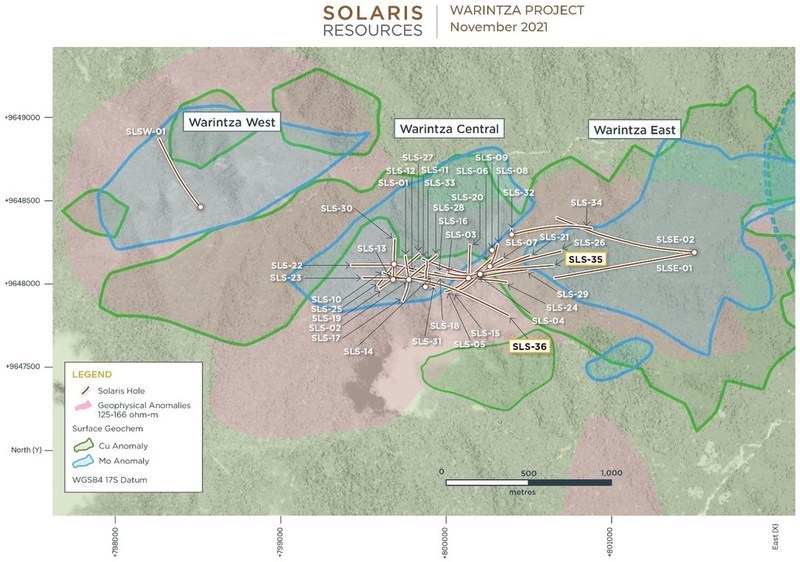

Figure 3 – Long Section of 3D Geophysics Looking Southwest
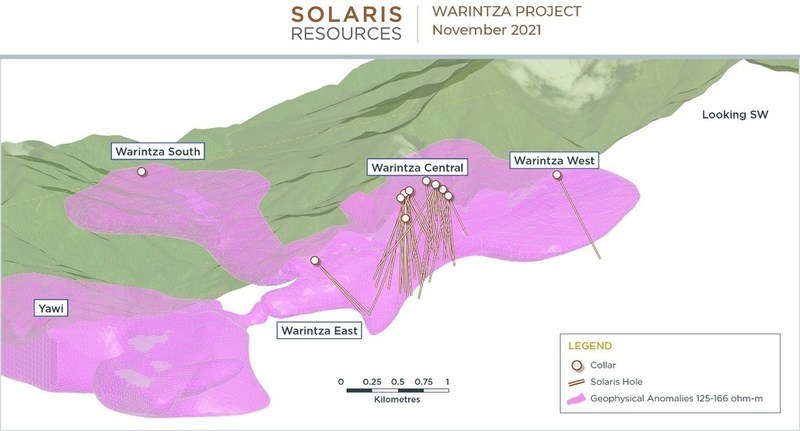

The above references an opinion and is for information purposes only. It is not intended to be investment advice. Seek a licensed professional for investment advice. The author is not an insider or shareholder of any of the companies mentioned above.


Kuya Silver Corporation (CSE:KUYA) announced on Wednesday it would be commencing a new 2,000m+ drill program at the Silver Kings Joint Venture located in Northeastern Ontario. It will be part of the Company’s larger Silver Kings Project, located in the historical Cobalt silver mining camp.
The drill program was created in order to test high-grade silver-cobalt veins whose depths were based on a number of statistics including 2021 field mapping and portable XRF analyses, soil sampling, and LiDAR lineament analysis, taking into consideration historical work and data.
The program’s drill targets are mainly in the newly identified “Oxbow area” which is associated with the historic Silver Centre mining camp. The zone has not been thoroughly tested and is said to be a southern continuation of the mineralizing system from the mines at Silver Centre area according to Kuya. It produced more than 23 million ounces of silver between 1908 and 1965 from several historic mines including Keeley and Frontier.
David Stein, Kuya President and CEO, said, “Based on Kuya’s work on the joint venture to date, we have identified the Oxbow target area as a priority for the potential discovery of multiple or clusters of high-grade silver veins. Our target is the potential for buried mineralization that was missed during the previous mining campaigns over the past 120 years.”
The involved drilling has a valid permit that will allow target structures to be intercepted, “along a plunge of mineralization, within 100 vertical meters of the Nipissing Diabase contacts in the historically named Productive Zone.”
David Lewis, Exploration Director for Kuyra Silver, commented, “The major controls on silver-cobalt mineralization in the Cobalt and Silver Centre mining camps are 1) proximity to the upper and lower contacts of the Nipissing Diabase sill, in particular near flexures or folds in the sill, and 2) proximity to major structures, especially faults.
At Silver Centre, the majority of mining and exploration was focused above the diabase; in contrast, in the main Cobalt mining camp to the north, including at Kuya’s 100%-owned Kerr Project, the bulk of economic mining was from below the diabase. We see a major opportunity to test below the diabase contacts near Silver Centre in this drill program.”
While the Silver Kings project in Ontario, Canada has received more attention, Kuya Silver also operates outside of Canada. The company has another current project, the Bethania Silver project. Bethania is located in Central Peru.
The above references an opinion and is for information purposes only. It is not intended to be investment advice. Seek a licensed professional for investment advice. The author is not an insider or shareholder of any of the companies mentioned above.
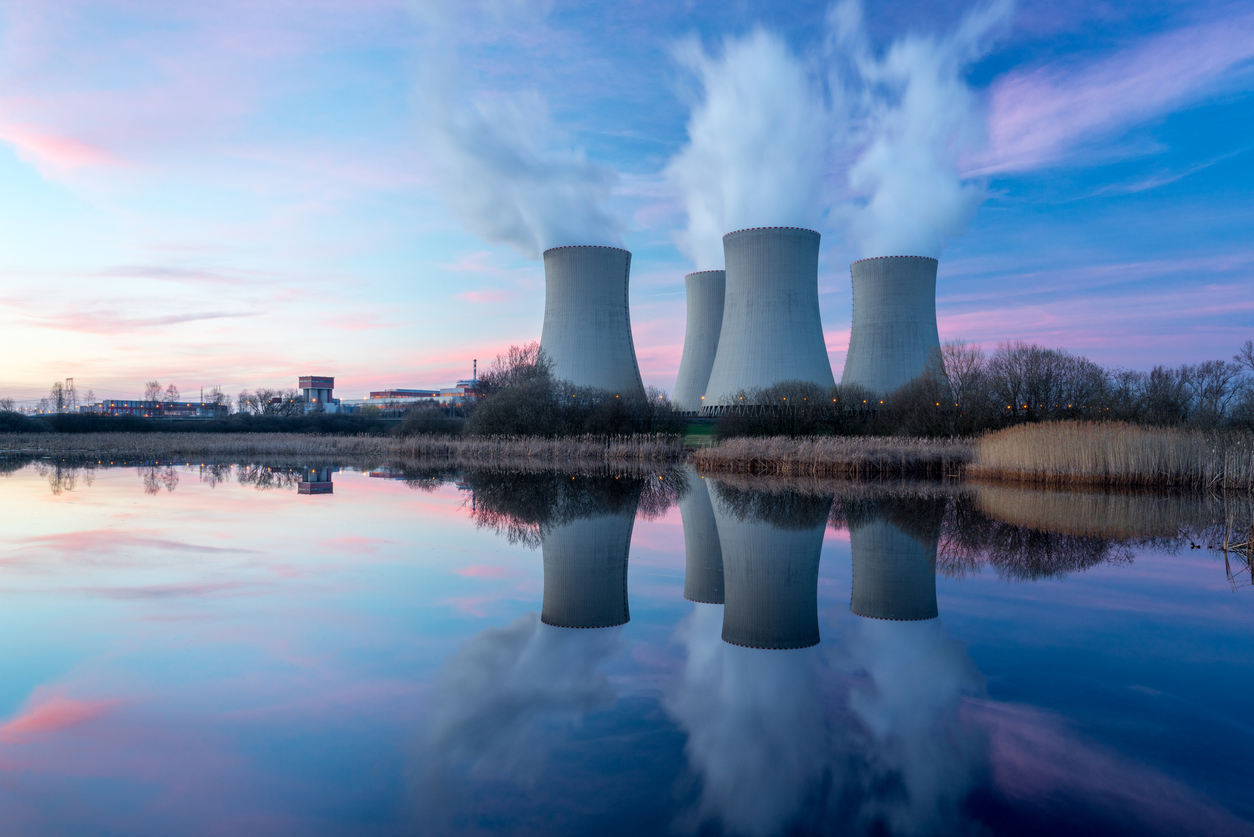

Consolidated Uranium (TSXV:CUR) announced on Wednesday it has made an agreement to acquire 100% interest in the Milo uranium, copper, gold and rare earth project in Australia.
The Milo project includes Exploration Permit – Minerals 14416, “which consists of 20 sub-blocks or approximately 34 square kilometres located within The Mt Isa Inlier, which is approximately 40 kilometres west of Cloncurry in Northwestern Queensland.
President and CEO of CUR (the subsidiary of Consolidated Uranium acquiring the asset) Philip Williams stated, “With today’s signing of the Agreement, the Transaction will add another uranium project to the CUR portfolio with significant previous expenditures and historic mineral resources. Like many of our other projects we believe that Milo boasts strong exploration potential which we intend to pursue in short order. The project also fits well with our existing Queensland assets, namely Ben Lomond and Maureen, and will provide critical mass in an important global mining jurisdiction. We feel strongly that Milo will be a valuable project to CUR as it may be advanced as a uranium asset with additional historic mineral resources of rare earths, copper, and gold.”
Base and precious mineralization can be found at the Milo deposit, which is a large IOCG breccia style system with sulfide-rich breccia zones surrounded by a zone of TREEYO-P2O5 enrichment forming a halo to the base metal mineralization.
There have been a total of 32 holes drilled at the deposit by GMB from 2010 to 2012, which extended the mineralization north and south. Oxidation is said to be generally shallow, and there are currently no drill holes that penetrate the oxidized mineralization.
Williams concluded, “Currently the Queensland Government of Australia is highlighting rare earths as a priority for development as part of its New Economy Mineral Initiative. In October 2020 the Premier for Queensland announced a Government Initiative to develop New Economy Minerals within The North West Mineral Belt. Within this report, Milo was highlighted as one of the potential development projects.”
CUR says the exploration potential is very good and the majority of the previous drilling has been completed at The Milo Gossan. There is also a large, untested radiometric anomaly around 1 km north of the Milo project which has the largest radiometric anomaly on the tenement.
Multiple Exploration Options Are Available
There are also prospects north, south, and west of the project that have exploration opportunities yet to be explored:
- Milo North – Large U channel radiometric anomaly coincident with a pronounced topographic ridge. Little exploration has been done, and no drilling has been conducted.
- Milo South – “The gossan, approximately 400m in length, is in the center of the soil anomaly and is associated with an altered mafic unit, possibly dolerite.” No drilling has been conducted yet.
- Milo Western Gossan – “A 600 metre long, narrow linear gossan with pronounced structural complexity. The gossan was interpreted to occur at the margin of an intensely altered mafic unit and a sheared shale unit.” GMB has drilled six holes in five different sections.
The above references an opinion and is for information purposes only. It is not intended to be investment advice. Seek a licensed professional for investment advice. The author is not an insider or shareholder of any of the companies mentioned above.


Lithium is a fundamental building block for the future of the world. As an essential component that drives green technologies and an essential element for the manufacture of energy storage systems, it has become indispensable for life on earth. This has led to its demand growing exponentially globally.
In order to boost the lithium market, promote sustainable production and increase competitiveness in the industry, the Chilean government has invited national and international companies to participate in a public search process for strategic partners to begin the exploration, exploitation and commercialization of new lithium deposits in the country.
With this call, 57 companies have expressed interest in new contracts in Chile to explore and produce lithium.
Chile will open tenders for the exploration and production of 400,000 tons of lithium to meet the high demand, the Ministry of Mining confirmed in a statement. These are special operating contracts with private and foreign companies until 2050 to sell lithium as raw material in the form of lithium carbonate or lithium hydroxide.
The Process
According to government information, the bidding process is in an initial phase, it is expected to have more information on the contracts by the end of this year, before the change of government.
The national and international call for bids will be made through a public, competitive and transparent process in order to tender and award contracts to produce a total of 400,000 tons of marketable metallic lithium, divided in five installments of 80,000 tons each, without a specific geographic location, detailed by the Ministry of Mining.
Participating companies may bid for 1 or 2 quotas, requesting each one, individually or through consortiums or related companies, to be awarded a maximum of 2 quotas for a total of 160,000 tons, in any area of the national territory.
The awards will be for a term of seven years, extendable for another two years to carry out the geological exploration, studies and development of the project in general, to which will be added another 20 years of production.
“It looks promising,” mentioned the minister of Energy and Mining Juan Carlos Jobet in an interview.
Chilean Lithium
After Australia, Chile is the largest lithium producer with 29% of the world’s supply but its market share has been compromised in recent years. Due to high demand for electric vehicles, Chile has decided to open up more of its huge reserves with the promise that this demand will keep lithium supplies tight for the next few years. The benchmark lithium index has doubled this year, as have prices in China.
Global lithium demand is expected to quadruple by 2030, reaching 1.8 million tons of lithium carbonate, according to ministry projections.
A Confluence of Events Creates Mild Uncertainty
Potential bidders are taking a high political risk in Chile as the whole process is taking place on the eve of presidential and parliamentary elections. In addition, Chilean President Sebastián Piñera has been impeached following revelations from the Panama Papers leak.
At least one opposition senator has accused the center-right government of trying to rush through the new contracts at a time when the country is reviewing its stance on natural resources while a new constitution is being drafted.
Albemarle Corp. (NYSE:ALB), one of only two existing producers in Chile, has purchased the bidding documents, but said that part of its due diligence is to evaluate the next government’s stance on the process.
Currently, the Chilean company and the US company Albemarle SQM operate in Chile at the Salar de Atacama, one of the richest lithium deposits in the world. Before the companies can develop their projects, they will have to carry out exploration work and process the necessary permits to produce up to 80,000 metric tons each for 20 years, the U.S. Geological Survey said.
The above references an opinion and is for information purposes only. It is not intended to be investment advice. Seek a licensed professional for investment advice. The author is not an insider or shareholder of any of the companies mentioned above.
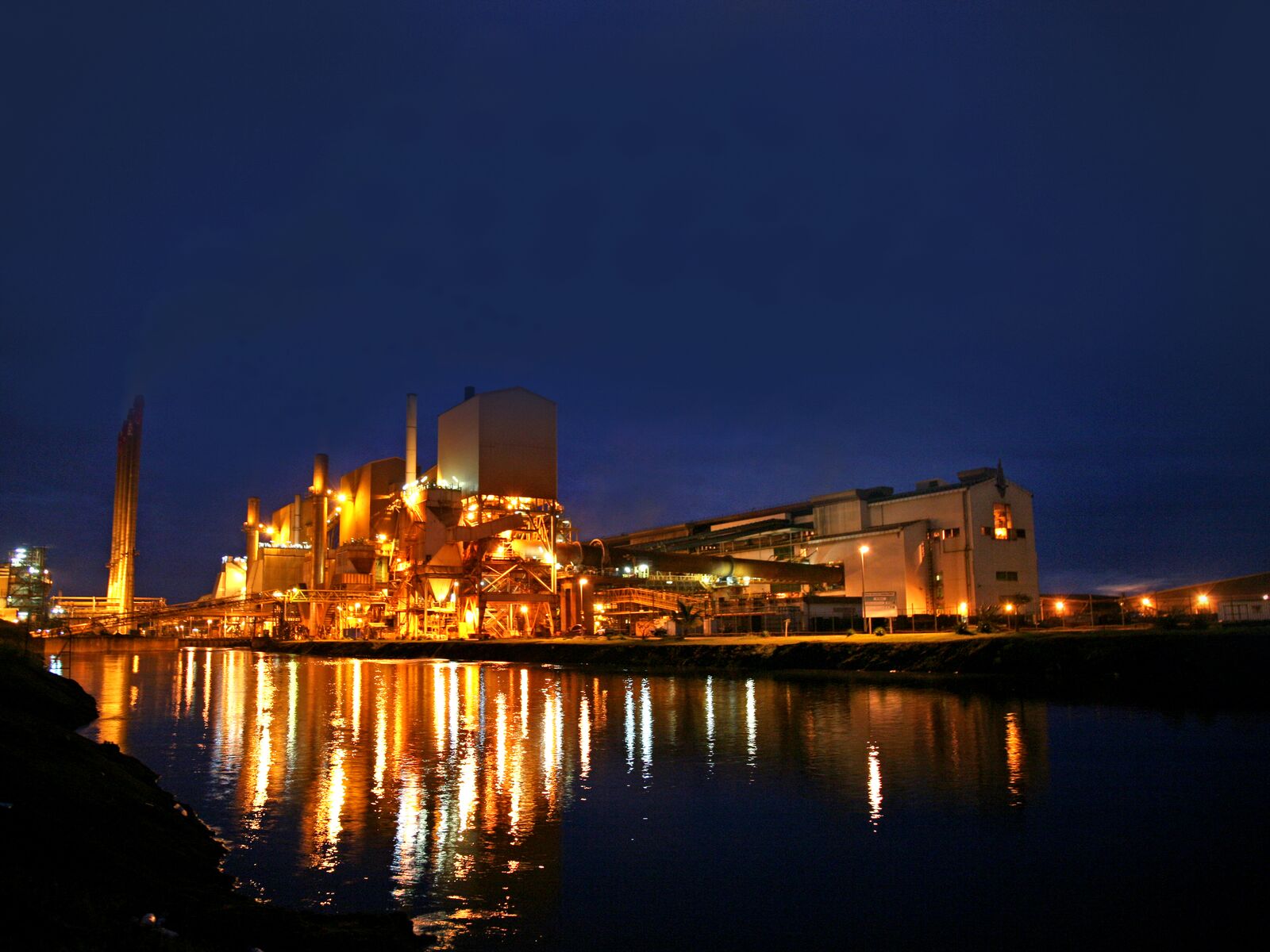

Eramet is teaming up with China’s Tsingshan Holding Group to build a $400 million lithium plant in Argentina. The French miner already owns a significant lithium deposit in Argentina, but the deal comes as demand for lithium continues to skyrocket and market level prices in China reach record highs. The lithium deposit that Eramet does already own halted its production in April 2020 due to the global Covid-19 pandemic.
Eramet will control the project and hold the operational management responsibility with a 50.1% stake, while Tsingshan will finance as much as $375m of the project in exchange for a 49.9% interest.
The Tsingshan Holding Group is the world’s leading stainless steel producer, and the two have had previous success working together in nickel production at Weda Bay in Indonesia. Eramet Group is known for successfully recovering and developing essential metals such as manganese, nickel, mineral sands, lithium, and cobalt.
The new plant is scheduled to begin production in the second quarter of 2022 and will be commissioned in early 2024. The plant is expected to have an annual production of 24,000 tonnes of lithium starting from 2024, according to a statement regarding the deal from Eramet.
Having an operational lithium deposit is ideal as the green energy transition and electric vehicle movement are bigger than ever.
Christel Bories, Eramet group chair and CEO said in a statement “Our decision to carry out our lithium project in Argentina is in line with the dynamic of strong market growth. It is a key milestone in the deployment of our strategic roadmap which aims at positioning Eramet as a reference player in metals for the energy transition.”
The size of the deposit will allow further capacity expansion to be considered through the construction of other similar plants by the two partners, according to the released statement. Eramet is also involved in talks regarding “potential supply agreements” with battery makers and car manufacturers.
“Eramet will thus become the first European company to operate a sustainable and large-capacity lithium industrial complex: we take pride in this project and see an opportunity for Europe’s sovereignty to secure tomorrow’s critical metals. For this project with high value creation potential, our partner Tsingshan will provide its industrial expertise and financing capabilities needed for the construction of the plant,” Bories continued.
The Demand for Lithium
The demand for lithium is at an extreme high and is expected to soar even higher in the next decade. Not only is it in demand because many productions came to a halt due to the COVID-19 pandemic, but because the electric vehicle and green energy movement is happening simultaneously. By 2030, the total global demand for lithium is projected to reach 1.79 million tonnes of lithium carbonate equivalent.
However, Market analysts from Benchmark Mineral Intelligence (BMI) are actually predicting a lithium shortage from 2022 onwards.
George Miller, an analyst at BMI said “unless we see significant and imminent investment into large, commercially viable lithium deposits, these shortages will extend out to the end of the decade.”
Lithium projects such as this deposit in Argentina will be critical in preventing this shortage prediction by boosting the overall lithium supply, and keeping up with the demand surrounding the electric vehicle and green power movement.
“Since Eramet has decided to team up with China’s Tsingshan Holding Group to build a $400 million lithium plant in Argentina.The French miner already owns a significant lithium deposit in Argentina, but the deal comes as demand for lithium continues to skyrocket and market level prices in China reach record highs. The lithium deposit that Eramet does already own halted its production in April 2020 due to the global COVID-19 pandemic.
Eramet will control the project and hold the operational management responsibility with a 50.1% stake, while Tsingshan will finance as much as $375m of the project in exchange for a 49.9% interest.
The Tsingshan Holding Group is the world’s leading stainless steel producer, and the two have had previous success working together in nickel production at Weda Bay in Indonesia. Eramet Group is known for successfully recovering and developing essential metals such as manganese, nickel, mineral sands, lithium, and cobalt.
The new plant is scheduled to begin production in the second quarter of 2022 and will be commissioned in early 2024. The plant is expected to have an annual production of 24,000 tonnes of lithium starting from 2024, according to a statement regarding the deal from Eramet.
Having an operational lithium deposit is ideal as the green energy transition and electric vehicle movement are bigger than ever.
Christel Bories, Eramet group chair and CEO said in a statement “Our decision to carry out our lithium project in Argentina is in line with the dynamic of strong market growth. It is a key milestone in the deployment of our strategic roadmap which aims at positioning Eramet as a reference player in metals for the energy transition.”
The size of the deposit will allow further capacity expansion to be considered through the construction of other similar plants by the two partners, according to the released statement. Eramet is also involved in talks regarding “potential supply agreements” with battery makers and car manufacturers.
“Eramet will thus become the first European company to operate a sustainable and large-capacity lithium industrial complex: we take pride in this project and see an opportunity for Europe’s sovereignty to secure tomorrow’s critical metals. For this project with high value creation potential, our partner Tsingshan will provide its industrial expertise and financing capabilities needed for the construction of the plant,” Bories continued.
The Demand for Lithium
The demand for lithium is at an extreme high and is expected to soar even higher in the next decade. Not only is it in demand because many productions came to a halt due to the COVID-19 pandemic, but because the electric vehicle and green energy movement is happening simultaneously. By 2030, the total global demand for lithium is projected to reach 1.79 million tonnes of lithium carbonate equivalent.
However, Market analysts from Benchmark Mineral Intelligence (BMI) are actually predicting a lithium shortage from 2022 onwards.
George Miller, an analyst at BMI said “unless we see significant and imminent investment into large, commercially viable lithium deposits, these shortages will extend out to the end of the decade.”
Lithium projects such as this deposit in Argentina will be critical in preventing this shortage prediction by boosting the overall lithium supply, and keeping up with the demand surrounding the electric vehicle and green power movement.
“Since the early phases of the project in 2019, the teams have remained highly committed, preserving the assets and maintaining strong relationships with all stakeholders. We are now ready to engage the site’s development in the best conditions,” concluded Bories.
“From the early phases of the project in 2019, the teams have remained highly committed, preserving the assets and maintaining strong relationships with all stakeholders. We are now ready to engage the site’s development in the best conditions,” concluded Bories.
The above references an opinion and is for information purposes only. It is not intended to be investment advice. Seek a licensed professional for investment advice. The author is not an insider or shareholder of any of the companies mentioned above.
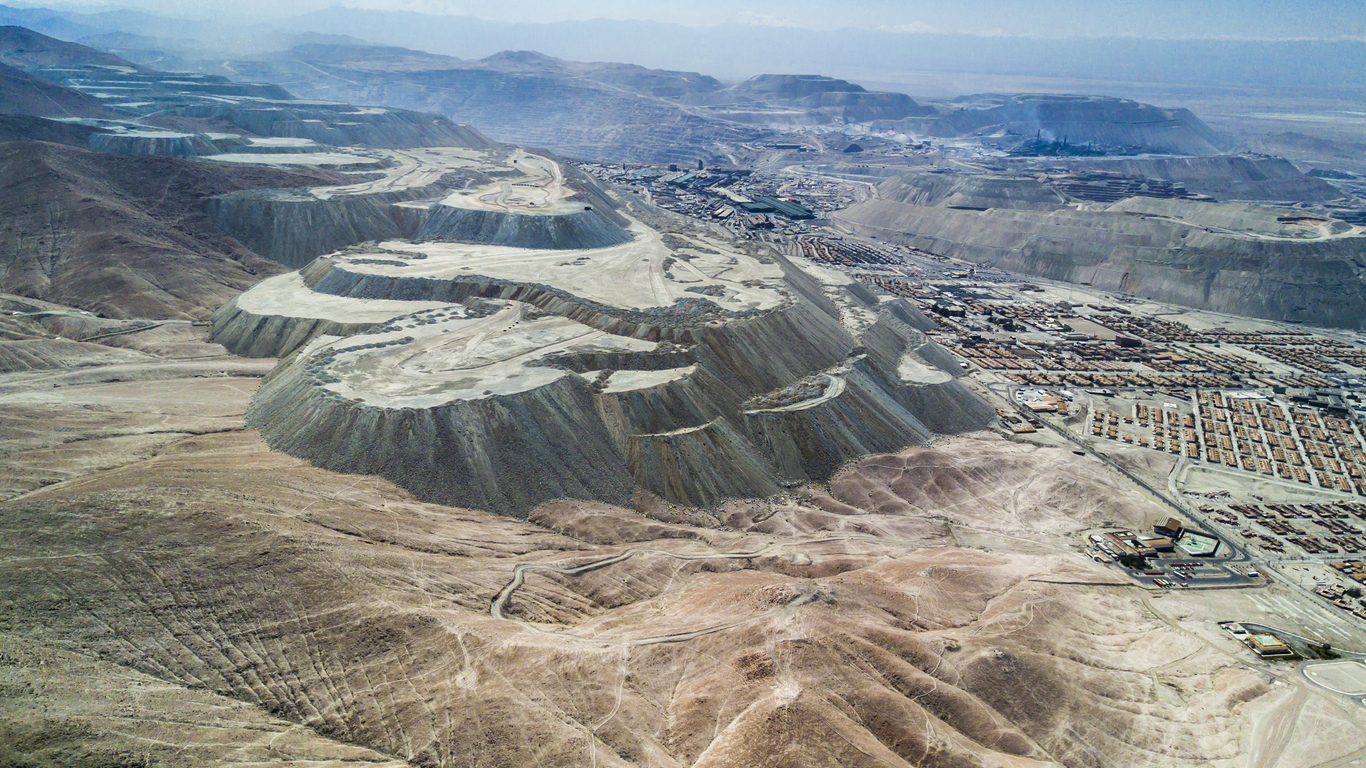

It was announced on Monday that by the end of the decade Chile should receive just under $7 billion in mining investments, according to Chile’s state copper commission Chochilo. Since two projects ended up being removed from the pipeline, it resulted in a 6.9% decrease from the previous forest.
Although two were removed, five new mining projects involving gold, iron, copper, and industrial minerals were added, Chochilo said.
Codelco pushed back the starting date of beginning its $3.2 billion expansion of its Andina copper project to 2035, while also cutting $1.95 billion in investment costs. Codelco also has seven different mining divisions with projects in different regions including Camala and Machali.
Chile is the world’s top producer of copper. According to Trading Economics global macro models and analysts’ expectations, “Copper production in Chile is expected to be 550,000 tonnes by the end of this quarter.” Approximately 27.8% of the pipeline’s value will go towards state-owned miners Codelco and Enami, while the majority of the funds will be put towards copper mining.
Chile is not the only country with pipeline projects on the go. Peru, the world’s second top producer of copper, has a mining pipeline project estimated by the government to be worth around $50 billion.
The 21 de Mayo Project
Chile is also home to the copper mining project The 21 de Mayo Project. It is owned by Compania Minera San Geronimo and has plans to continue operation until 2027. “The mine produced an estimated 65.015Mt of ROM in 2020. It had an estimated production of 305.44 thousand tonnes of copper in 2020.”
The Compania Minera San Geronimo was first introduced to the Rendic family in the 1960’s and remained closed for another 20 years before becoming operational. They started out as a small to medium size mining company and over the years made a name for themselves and are now one of the biggest producers in the sector. They not only produce copper concentrate but other materials derived from the mineral as well.
They started out producing food-grade copper for livestock owners, producing about 10,000 tons per year. San Geronimo also created their own fertilizer formula called Ferticopper, which was used to meet the nutritional needs of all different kinds of crops. Not only did they create this new fertilizer, but they also created a system to obtain their copper right from the ground on-site, instead of using copper scrap to generate their products.
As competition grew over the years, the company decided to create another new form of copper called Agrocopper, which made them stand out from competitors. This product could be used all throughout the year, “had a wide coverage, was soluble in water, neutral PH and will not affect or contaminate the crops or the soil.” It also was not harmful to the ground, and a small dose allowed better control over fungi and plants throughout the year.
San Geronimo launched this product in 2016 the transnational pharmaceutical company Bayer caught wind and decided to start distributing it in Chile and today plan on taking it to Latin America. It is a unique product that allows farmers to save money by purchasing one reasonably priced product for their crops rather than being unorganized with ten different crop and soil products.
The above references an opinion and is for information purposes only. It is not intended to be investment advice. Seek a licensed professional for investment advice. The author is not an insider or shareholder of any of the companies mentioned above.
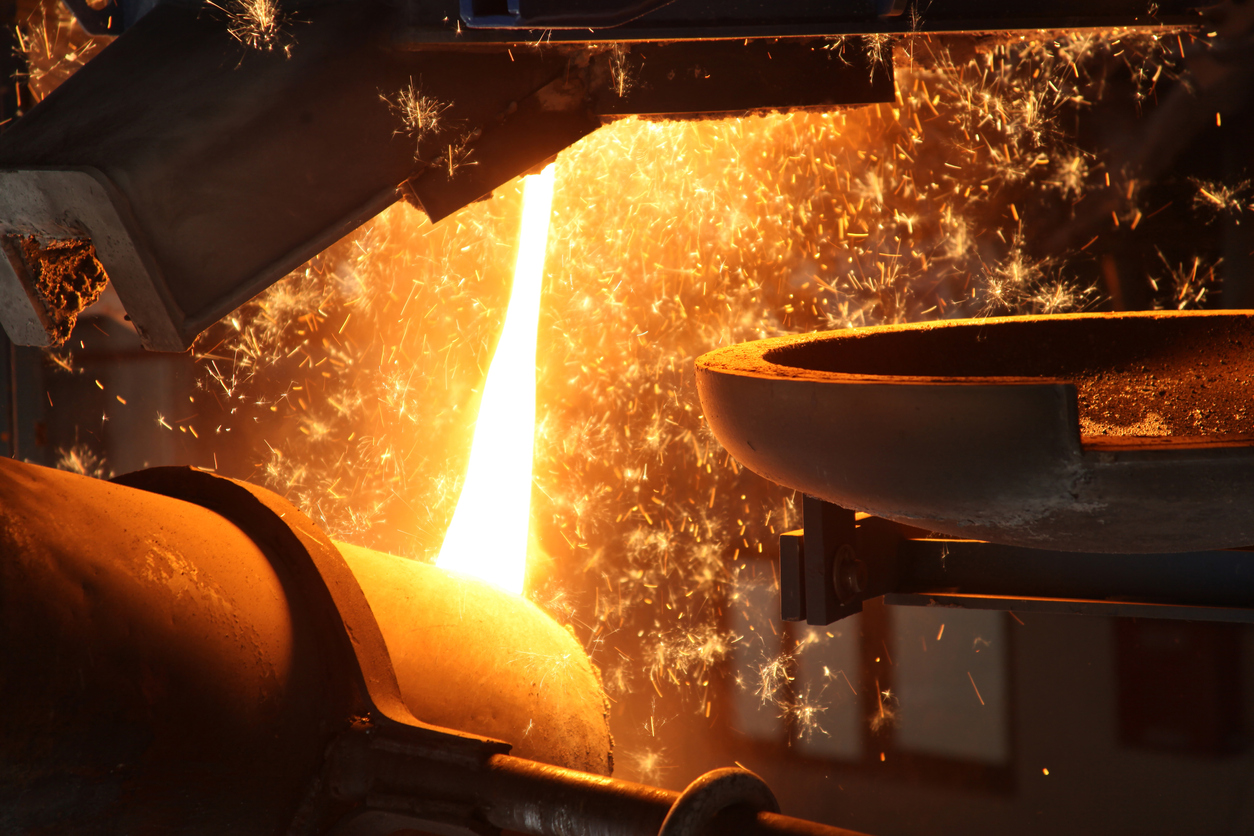

Alcoa Corp. (NYSE: AA) announced that the Portland Aluminum Joint Venture plans to restart 35,000 tonnes per annum of reduced capacity at its aluminum smelter in Victoria, Australia. The process has been inactive since 2009 and plans to restart production facilities will start immediately, with metal production expected in the third quarter of 2022.
Portland Aluminum has a long history of community support has enabled the company to have an additional positive social impact through additional jobs and local costs. Portland Aluminum is an unincorporated joint venture with a total capacity of 358,000 tonnes per annum and will operate at roughly 95% of its total capacity upon restart. The Alcoa Corporation consolidated production capacity is 197,000 tonnes per annum and the total production capacity in Portland will be approximately 186,000 tonnes per annum.
The project will also lead to the creation of new jobs for about 80 people, about 30 permanent jobs in the foundry, and about 50 temporary construction sites. The foundry currently employs about 680 employees including direct employees and subcontractors.
Alcoa has already spent about $300 million to expand its Iowa plant and plans to spend another $150 million on other facilities to meet the demand for aluminum, particularly Ford trucks.
The automotive industry and its consumers initially remained reluctant to buy cars that used aluminum rather than steel. People who know and love Ford know that steel is the brand’s strength, which is why concerns arose when it was announced that aluminum would be used. Industry officials also expressed concern that aluminum is already much more expensive than steel and rising demand could push prices up further. Not to mention, the auto industry has been associated with steel mills for years and the transition to a different metal is a big change.
As part of the Life Cycle Agreement, the company also recently received government assistance to remain open for another five years after Alcoa threatened to close the Portland Foundry to reduce costs and emissions. Since Portland Foundry is the largest electric utility in Victoria, it needs a ton of electricity that could actually drive up energy costs. However, he managed to seal an economic deal with AGL Energy, Origin Energy, and Alinta Energy as agreed in March.
The exclusive supplier of the plant, AGL Ltd, announced on Monday it has agreed to provide 72 megawatts of additional capacity for four years starting in July 2022 to restore capacity. The reboot is expected to cost approximately $ 28 million, split between Foundry Co-owners Alcoa, Australia – Alumina Ltd and subsidiary of CITIC Resources and Japan – Marubeni Corp. The reboot cost is expected to be incurred between the fourth quarter of 2021 and the third quarter of 2022.
Alcoa Corporation recently announced the restart of its 268,000 tpa smelting capacity at its Alumar smelter in Brazil, which is expected to be operational by the fourth quarter of 2022. Alcoa will receive approximately 82% of its 2.99 million tonnes of global aluminum smelting capacity when both projects are completed.
The above references an opinion and is for information purposes only. It is not intended to be investment advice. Seek a licensed professional for investment advice. The author is not an insider or shareholder of any of the companies mentioned above.


The tariff truce between the United States and the European Union initially appeared to be a win-win situation. But according to European Association (EAA) CEO Gerd Götz, it is actually a “lose-lose situation for the aluminum industry and its downstream customers on both sides of the Atlantic.”
The agreement is the result of the United States’ decision to eliminate tariffs on exports, keeping them at 25% on steel and 10% on aluminum. While the European Union, in response, will suspend the rebalancing measures it put in place to counter their impact.
The political sleight of hand causes one trade barrier to be exchanged for another and the cost of aluminum is unlikely to be reduced for European or U.S. consumers
“The United States looks forward to partnering with other key trading partners and stakeholders to address the global challenge of excess steel and aluminum” stated the Commerce Department in a press release last October 31.
Tariffs to be Replaced by Quotas
The dispute dates back to 2018 when the administration of former President Donald Trump introduced tariffs on steel and aluminum from Europe, Asia and elsewhere citing national security risks.
On the other hand, tariffs on European imports will be replaced by tariff-free quotas based on 2018-2019 volumes. This translates into 18,000 tons of unwrought aluminum and 36,00 tons of forged products.
“Eliminating this tariff burden on U.S. whiskeys boosts farmers and distillers and also supports the recovery of EU restaurants, bars and distilleries affected by the pandemic,” said Chris Swonger, director of the Distilled Spirits Council of the United States.
Joe Biden’s administration is limited to alternating policy options set out in the U.S. Department of Commerce’s Section 232 analysis.
This report suggested that “specific countries” could be partially or fully exempted from the tariffs based “on an overriding U.S. economic or security interest, which could include its willingness to address global overcapacity and other challenges facing the U.S. aluminum industry.”
The goal of the tariffs Trump introduced in 2018 was to achieve steel and aluminum production above the 80% level.
As a result of the tariffs, U.S. production increased from 741,000 tons in 2017 to 1,126,000 tons in 2019.
In the first nine months of 2021, domestic primary metals production fell 16% with an annualized September production rate of 901,000 tons. That is, a capacity utilization rate of solor 50%, despite the aluminum price jumping to a year-on-year high of $3,229 per ton from below $2,000 per ton in the first quarter of 2018, just before tariffs went into effect.
Midstream manufacturers have benefited from the U.S. tariffs at the expense of downstream manufacturers as they end up paying the full tariff-adjusted price for aluminum. Even if the student comes from recycled sources.
Jake Colvin, president of the National Foreign Trade Council, said the agreement is a step in the right direction, however, the tariffs will continue to cause uncertainty for companies and their workers.
The EAA warned that the tariff quotas will lead to further trade distortions and create additional market instability for the value chain.
Meanwhile, the United Steelworkers union welcomed the agreement arguing that it will help keep the U.S. industry competitive.
What everyone agrees on is the ongoing need to restrict China’s excess capacity and exports.
President Joe Biden said the agreement with the EU “will help restrict access of dirty steel from countries like China to our markets.” But in China, they are fully aware of the growing differentiation between low-carbon aluminum and high-carbon aluminum, so this might not work for aluminum.
Hongqiao Group, China’s largest private operator has already moved 1 million tons of capacity to tap into the hydropower resources of Yunnan province which is home to the country’s largest aluminum capacity that is powered by renewable energy. This could increase the amount of “green” aluminum that could be low carbon enough to penetrate the carbon walls of Europe or anyone else.
China may not have attended COP-26 but its decarbonization campaign is still having a direct impact on aluminum.
The above references an opinion and is for information purposes only. It is not intended to be investment advice. Seek a licensed professional for investment advice. The author is not an insider or shareholder of any of the companies mentioned above.


Short-term copper contracts on the LME are trading at a giant premium to futures, which is a clear sign that the unprecedented tightness from last month in spot supplies is far from over.
The London Metal Exchange is currently experiencing a condition called backwardation, which is what happens when spot demand is rising higher and faster than supply.
This resulted in premiums for spot contracts rising to record levels in the past month. Inventories are currently at a multi-decade low as the surging premiums for spot contracts point to a supply shortfall for the LME.
Similarly to the October squeeze, buyers on the LME are once again paying huge premiums to roll forward front-month contracts. At the close of trading on Monday, the spread between November and December contracts spiked to $275 a ton. This was one of the biggest backwardations ever seen on the bourse.
The hefty spot premiums and diminishing supplies of metal on the LME as well as other exchanges are creating mounting worries over demand that are dragging futures prices lower. A manufacturing slowdown in China and accumulating debt in its property sector resulted in three-month prices falling 10% compared to last month’s peak.
Setting New Records
During last month’s unprecedented squeeze, the backwardation in the front two monthly contracts surged to a record $1,060 a ton. This pushed LME to introduce emergency measures in an effort to try to restore order. These preventative steps will likely help the backwardation not rise to such extremes in the future again, however, buyers could yet come under further pressure ahead of the expiry of the November contract in just under two weeks’ time.
According to LME data, there are still more than 17,300 outstanding contracts that will need to be settled before the November contract expires. This means sellers have two options, to either buy the contracts back or find copper to deliver into LME warehouses. The open interest in November contracts is equal to 433,775 tons, which equates to just about 14 times the amount of metal that is available to buyers in the LME’s warehouse network.
Even with the rising backwardation, copper and other base metals entered the spotlight on Tuesday as concerns continue to grow surrounding a slowing Chinese economy and elevated inflation. While the global energy crisis keeps throttling metals supplies, concerns about China’s growth are building due to the power crisis, real-estate deleveraging, and coronavirus outbreaks.
These are serious concerns regarding the strength of the broader rally in commodities that pushed a Bloomberg gauge of raw materials and the LME’s index to record highs last month. As traders awaited key central bank decisions amid concerns about inflation, the overall market sentiment jumped and the dollar was little changed ahead of a key Federal Reserve meeting. An announcement is expected about plans to taper its massive bond-purchase program.
Earlier in the year, China had announced they would be monitoring market conditions and will continue to release copper, aluminum, and zinc from its state reserves, in an effort to overcome mismatches between supply and demand.
As of September of this year, China had released 420,000 tonnes of the metals in three batches so far via public auctions at prices slightly lower than market value. Last Saturday, China released its fourth batch of 150,000 tonnes of industrial metals from its state reserves to help ease supply and demand tightness.
It is unclear how many more batches would be necessary to help supply catch up to the high demand, and it is likely there is no way to fully close the gap between the two for copper in the immediate future.
The above references an opinion and is for information purposes only. It is not intended to be investment advice. Seek a licensed professional for investment advice. The author is not an insider or shareholder of any of the companies mentioned above.
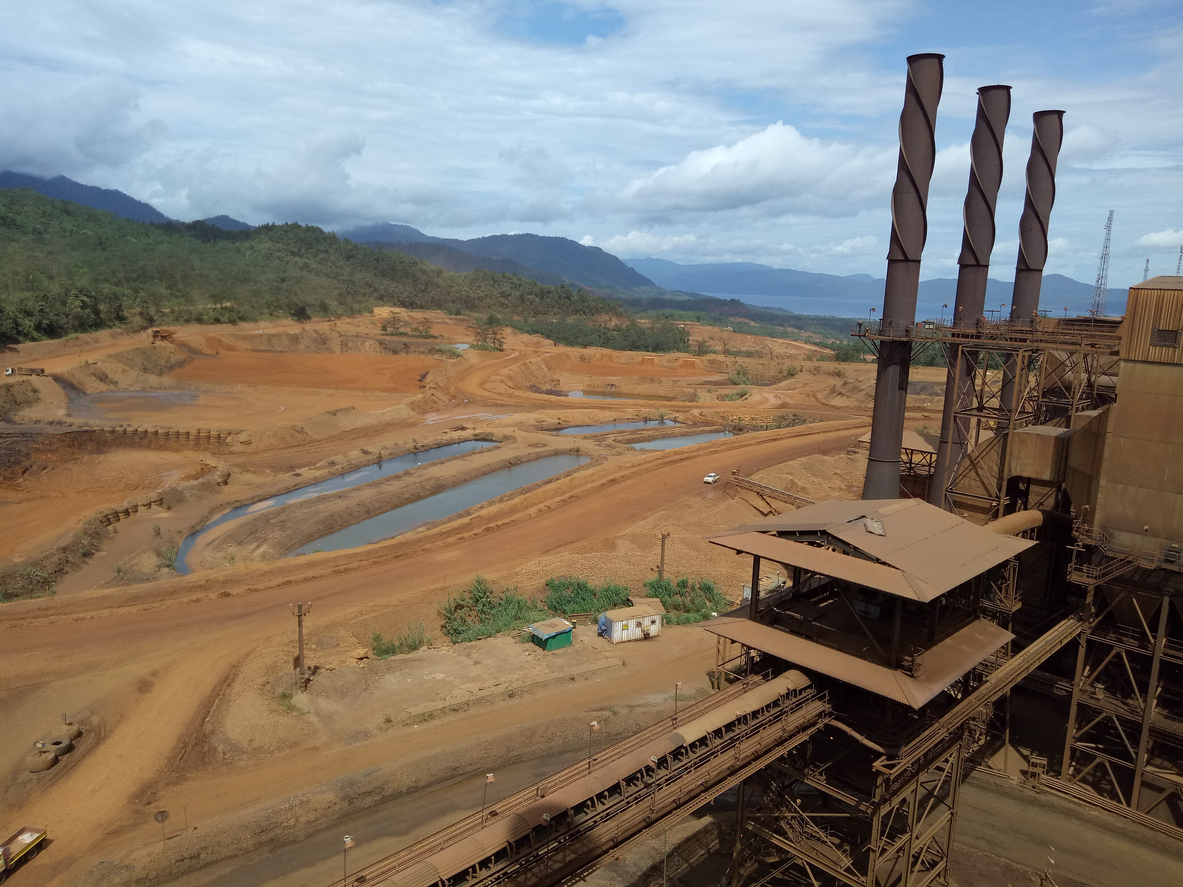

Talks have begun between BHP (ASX:BHP), the world’s biggest mining company, and billionaire Andrew Forrest’s Wyloo Metals in regards to the takeover of Noront Resources, a Canadian nickel company.
Both companies are trying to acquire the nickel producer, but in October BHP increased its all-cash offer for Noront to C$0.75 per share. This offer surpassed Wyloo’s $0.70 proposal, which promoted the discussion between the two companies.
“BHP and Wyloo Metals have engaged in initial conversations and are considering a mutually beneficial arrangement regarding the acquisition of Noront by BHP,” the company said in a statement.
Acquiring Noront would include the Eagle’s Nest nickel asset in Canada’s so-called Ring of Fire, a high-grade deposit of the electric-vehicle battery metal, as well as copper and palladium.
“Wyloo Metals is considering the potential of a mutually beneficial arrangement with BHP insofar as this arrangement can deliver greater deal certainty to Noront shareholders,” Wyloo said in a statement on Wednesday.
BHP announced on Tuesday it has made the decision to extend the tender expiry for its takeover from Nov. 9 to Nov. 16.
The Drive for Nickel Now
Nickel is a popular metal for lots of things but one of the most well-known uses is to make alloys for steel. Steel is used in products such as cookware, cutlery, and even medical equipment because it is easy to keep clean. Mining nickel is a similar process to mining copper and may even use the same equipment in some scenarios. Nickel comes from ores, either sulfide or a laterite ore, which will use different procedures depending on which you are mining.
The future of nickel mining is bright as the demand for stainless steel and alloys remains consistent, as well as the electric vehicle movement becoming more popular than ever. Lithium is known to be used widely in EV’s, but nickel is also used in rechargeable batteries, which makes it handy for the EV market as well.
It is important for companies and legislation to closely watch nickel production as it can be harmful towards the environment when produced in excessive amounts.
As the company focuses on Noront, BHP is also focused on reducing its presence and operations in the coal industry, but not as quickly as once predicted. BHP have been planning to exit the coal industry for at least two years now and still have ties to certain mines as the asset is becoming more valuable due to coal’s rally.
BHP has already sold a stake in the Cerrejon thermal coal mine in Colombia and is close to a deal to sell some Australian coking coal mines. However, they are taking their time with the Mt Arthur mine in Australia and considering potential better future offers if they arise since coal is becoming more valuable.
A Difficult and Slow Exit
According to people familiar with the matter, BHP has already declined offers for Mt Arthur that didn’t meet its valuation “with uncertainty around future liabilities.”
The Company was looking into exiting the industry, along with other big names such as Anglo American Plc because investors were not comfortable with these huge companies mining the dirtiest source of fuel. However, the urgency is much less and it is unclear if and when it will rise again.
BHP CEO Mike Henry last month said the plan to exit thermal coal was largely business-based, rather than being driven solely from an environmental standpoint.
There “wasn’t any push toward becoming fossil-fuel free,” he said at a shareholder meeting. “It was simply a cold-eyed assessment on how those commodities fit with the BHP portfolio, how we saw the long-term value and the ability to compete for capital in the BHP portfolio.”
Prices for thermal coal exported from Australia also spiked last month to a record high. The cost is beginning to drop again though as China creates plans to ease a supply crunch that results in power outages.
The above references an opinion and is for information purposes only. It is not intended to be investment advice. Seek a licensed professional for investment advice. The author is not an insider or shareholder of any of the companies mentioned above.


Lithium Americas (TSX:LAC) announced on Monday they have decided to make an unconditional offer to obtain all of the outstanding shares from MilleniumLithium at $4.70 per share. The total offer sits around $400 million, and would result in an approximately 9.9% ownership of Millenium Lithium for shareholders, according to Friday’s prices.
About a month earlier in late September, China’s Contemporary Amperex Technology Co. (CATL), which is the world’s leading EV battery manufacturer, was shown to have been the highest bidder for Millenium Lithium. They created an offer of a total cash consideration of approximately C$377 million ($297m), which would be C$3.85 per share, however, Lithium Americas now has the highest offer.
The Millenium Lithium board has deemed this as the “superior offer” and has given CATL 10 business days to respond or match the offer if it chooses to do so.
Millenium Lithium has two non-producing lithium brine projects in Northern Argentina, which are the Cauchari East and Pastos Grandes lithium projects. The Cauchari East project is situated in the heart of the lithium triangle, which makes less of an impact on the environment while providing high-quality lithium. The Pastos Grandes project has had 23 wells drilled and covers a total of 12,619 hectares. Combined, these two projects have 4.12 million tonnes of lithium carbonate equivalent (LCE) in measured and indicated resources.
Other than their recent bid, Lithium Americas also has new and ongoing developments. The Company and its partner Ganfeng Lithium are currently developing the Caucharí-Olaroz lithium project in Jujuy province, Argentina. The project is expected to enter production in Q3 2022, and development is already underway for the Stage 2 expansion.
Cauchari-Olaroz
The Caucharí-Olaroz project actually got its name from the two salars in northwest Argentina where the project is located. It has an annual production capacity of 40,000 tonnes lithium carbonate equivalent (LCE) over a projected mine life of 40 years, but the stage 2 expansion is expected to add at least 20,000 tpa of production capacity to the operation, starting in 2025.
Jonathan Evans, CEO of Lithium Americas said in a news release: “In proximity to Caucharí-Olaroz, Millenium’s 100%-owned Pastos Grandes lithium brine project represents an attractive regional growth opportunity for Lithium Americas. As we bring Caucharí-Olaroz into production over the next year and continue to advance our Stage 2 expansion planning, the addition of this highly complementary lithium brine resource further enhances our long-term growth strategy in Argentina and leverages our technical and development expertise.”
Lithium Americas also has a second project on the go called the Thacker Pass, which is the largest known lithium resource in the United States. It is located in Nevada and already has a mine life of 46 years. This mine is actually located within an extinct supervolcano called the McDermitt Caldera, which formed 16.3 million years ago.
The Era of Lithium-Ion
Lithium is so important and widely used in everyday items such as mobile phones, remotes, laptops, digital cameras, and electric vehicles. It is used for making rechargeable lithium-ion batteries which all of these items heavily rely on. It is also used to make items without rechargeable batteries such as pacemakers and clocks.
The price of lithium spiked suddenly at the beginning of 2021 due to the high demand of the electric vehicle market. As long as this market remains in high demand and production stays steady, the need for lithium remains strong. As the trend of electric vehicles continues, lithium also plays a part in clean energy technology.
Lithium has a higher energy density and a longer lifespan than other metals and batteries, which is why it is great for efficient energy storage and electric vehicles. This high demand for products with rechargeable batteries and the electric vehicle movement is a great thing for lithium miners because it shows the market and demand are not slowing down any time soon.
The above references an opinion and is for information purposes only. It is not intended to be investment advice. Seek a licensed professional for investment advice. The author is not an insider or shareholder of any of the companies mentioned above.


The COVID-19 pandemic has affected different industries worldwide. One of the industries affected from an operational standpoint during that period is the mining industry.
Newmont (NYSE:NEM), the world’s leading gold producer, is facing a number of operational problems in addition to accelerating cost increases.
The Denver-based producer said in a recent report that it was forced to cut its annual bullion production target by 500,000 ounces while raising its cost projection.
The company raised its all-in sustaining cost forecast (AISC) to $1,050 per ounce, $80 higher than its previous forecast, citing lower production and higher royalties and taxes.
Newmont’s average gold prices were $1,778 representing a decrease of $135 per ounce from a year earlier.
After third quarter production fell to 1.45 million ounces versus the average estimate of 1.6 million ounces, Newmont announced a reduction in its full-year guidance. This reduction was from 6.5 million ounces to 6 million ounces due to difficulties at its Boddington, Western Australia and Nevada mines.
Newmont announced adjusted earnings of 60 cents per share for the quarter, down from 86 cents last year. That represents a 30% drop to $483 million as bullion prices and sales were down.
Next year production is expected to increase by about 5% and costs are likely to be in line with 2021 levels mentioned in a call with analysts, Tom Palmer, chief executive officer.
Who Is This Affecting?
Overall, the mining industry is facing a number of operational constraints due to the increased costs caused by the pandemic. Tight labor markets, movement and transportation constraints, and supply chain issues have affected the shipment of everything needed for exploration, development, and production.
All of these challenges have affected bullion producers more than base metal miners as gold prices have declined over the past year.
Society, governments and industries are working together to address all the challenges caused by the COVID-19 crisis. The aim is to support infected people, their families and communities to obtain sufficient treatment and vaccines for all.
The impact on the mining sector remains uncertain. However, this crisis has also brought lessons regarding how the pandemic affects commodity demand, supply chains and operating models.
A Resilient Industry
The mining industry has suffered six different crises over the past 40 years. The first was the second oil shock of the 1980s and the most recent was the commodity price shock.
In the analyses of the major crises of the last decades, a comparable pattern could be observed. Each crisis has been divided into four different phases of varying duration and extent. In each phase it can be observed that the crises progressed from a period of price shock, a demand shock, followed by supply and demand equilibrium and finally recovery and the beginning of the new normal.
It is believed by some analysts that the recovery has already begun due to the pickup in operations for the mining industry, and a return of normal production levels for many major miners.
Some Key Commodity Winners
Countercyclical metals such as gold and new industrial applications such as copper will be more resilient to shocks in supply and demand. Iron and metallurgical and thermal coal are likely to be more affected as construction demand falls along with energy requirements as the world transitions to a decarbonized economy.
Additionally, the copper undersupply plaguing the market right now will continue for decades as miners scramble to discover and produce more. New projects are not coming online fast enough to keep up with demand, and the shortage has some countries worrying about sustaining their supply.
Even despite projections based on past crises, there is significant uncertainty around the recovery and effectiveness of health systems to control the spread and impact of the virus.
The above references an opinion and is for information purposes only. It is not intended to be investment advice. Seek a licensed professional for investment advice. The author is not an insider or shareholder of any of the companies mentioned above.
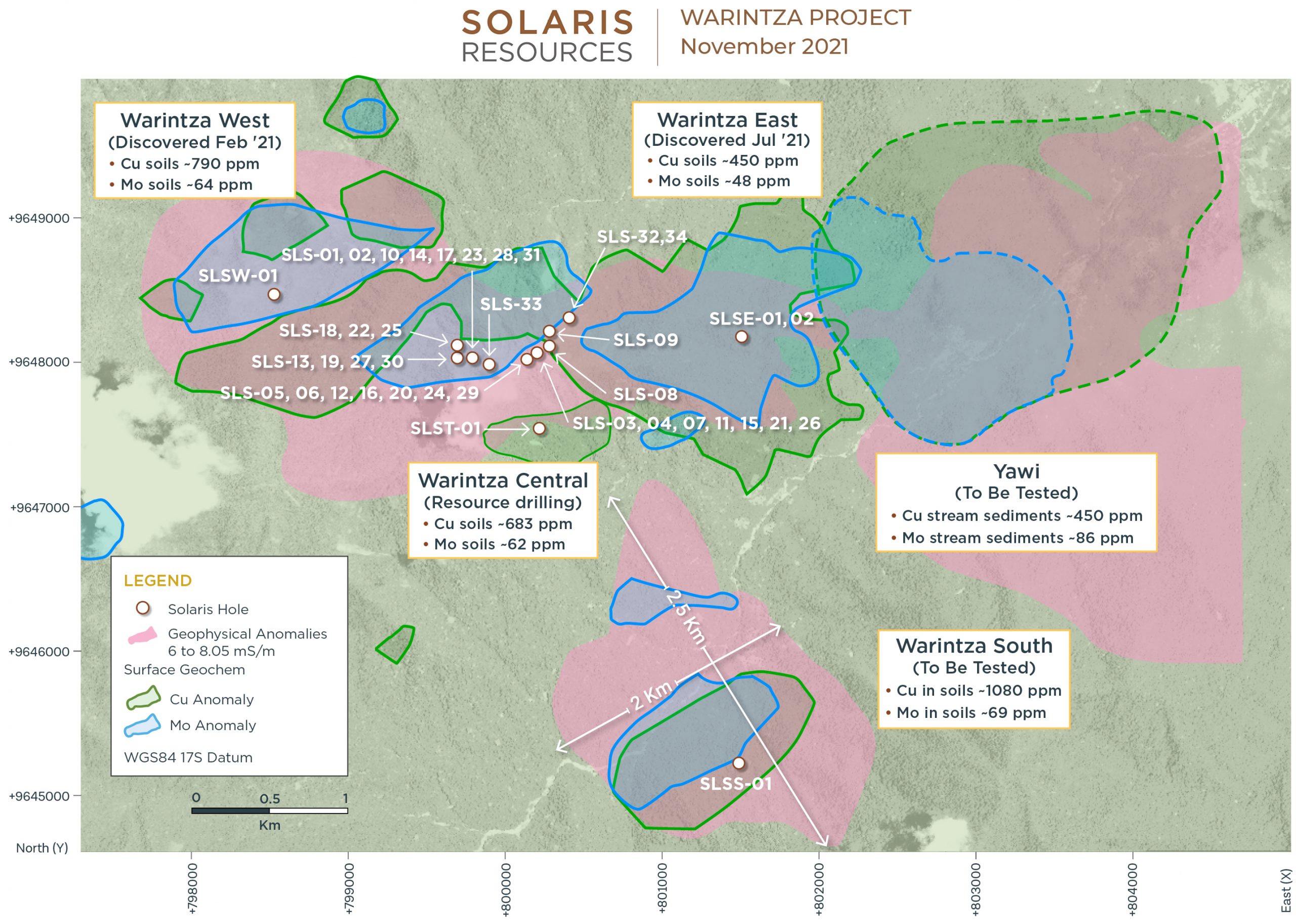

Solaris Resources (TSX:SLS) announced the commencement of maiden drilling at Warintza South this morning. In addition, updated results of detailed geophysical interpretation and geochemical sampling were delivered. The company has also refined and expanded the dimensions of the main objectives of the Warintza Project in southeastern Ecuador.
Mr. Daniel Earle, President and CEO of Solaris, said in a press release: “We are very excited to commence the first-ever drilling program at our voluminous Warintza South target, with the goal of making the fourth major discovery within our Warintza Project as we redirect our 12-rig drilling fleet toward aggressive step-out growth and discovery-oriented drilling over the balance of the year and into 2022.”
Highlights and corresponding Figures 1-3 are provided below. A dynamic 3D model featuring the updated geophysical and geochemical anomalies is available on the Company’s website.
Highlights
- Commenced maiden drilling at the Warintza South target, with the first hole collared ~3km south of Warintza Central (refer to Figures 1-3)
- The Warintza South high conductivity anomaly has dimensions more than twice the size of Warintza Central, and a similar geochemical signature where exposed at surface
- Updated interpretation has expanded the dimensions of the Warintza South high conductivity anomaly to ~2.5km x 2.0km x 0.7km and those of Warintza East and Yawi
- Additional geochemical sampling has also expanded the Warintza East anomaly further to the east and northeast where it now overlaps with Yawi
- Sampling continues to extend geochemical coverage over the sparsely sampled areas to the west and south of Warintza Central, and to targets beyond the Warintza porphyry cluster
Geophysical Reinterpretation
The Company retained Condor Consulting, Inc. (“Condor”), recognized experts in the field of airborne electromagnetics (EM), to perform detailed modelling and interpretation of the previously completed advanced airborne ZTEM survey (refer to press release dated February 16, 2021 for survey results) covering the entire 268km² Warintza and surrounding area land package.
Condor carried out a full 3D inversion of the EM and magnetic results using commercial and proprietary software producing enhanced images based on a greatly expanded dataset, including a considerable amount of additional drilling since the prior interpretation, and detailed geology, weathering and density models for the Project.
In general, the refined high conductivity volumes capture mineralization closer to surface and correlate more closely to networked sulfide mineralization in stockwork veining, with the anomalies now starting at surface and better reflecting the vertical zonation of the Warintza porphyries from higher density stockwork veining to lower density veining and disseminated mineralization.
Warintza South
Warintza South is defined by a voluminous high-conductivity anomaly located ~3km to the south of Warintza Central. The anomaly starts at surface and measures ~2.5km x 2.0km x 0.7km deep, with overlapping copper and molybdenum geochemical anomalies covering the exposed portion at surface.
Source: Solaris Resources
The above references an opinion and is for information purposes only. It is not intended to be investment advice. Seek a licensed professional for investment advice. The author is not an insider or shareholder of any of the companies mentioned above.
If you would like to receive our free newsletter via email, simply enter your email address below & click subscribe.
CONNECT WITH US
Tweets
Tweet with hash tag #miningfeeds or @miningfeeds and your tweets will be displayed across this site.
MOST ACTIVE MINING STOCKS
Daily Gainers
      |
LML.AX | +125.00% |
      |
GCR.AX | +33.33% |
      |
CASA.V | +30.00% |
      |
AHN.AX | +22.22% |
      |
ADD.AX | +22.22% |
      |
AZM.V | +21.98% |
      |
NSE.V | +21.05% |
      |
DYG.V | +18.42% |
      |
AAZ.V | +18.18% |
      |
GLA.AX | +17.65% |













